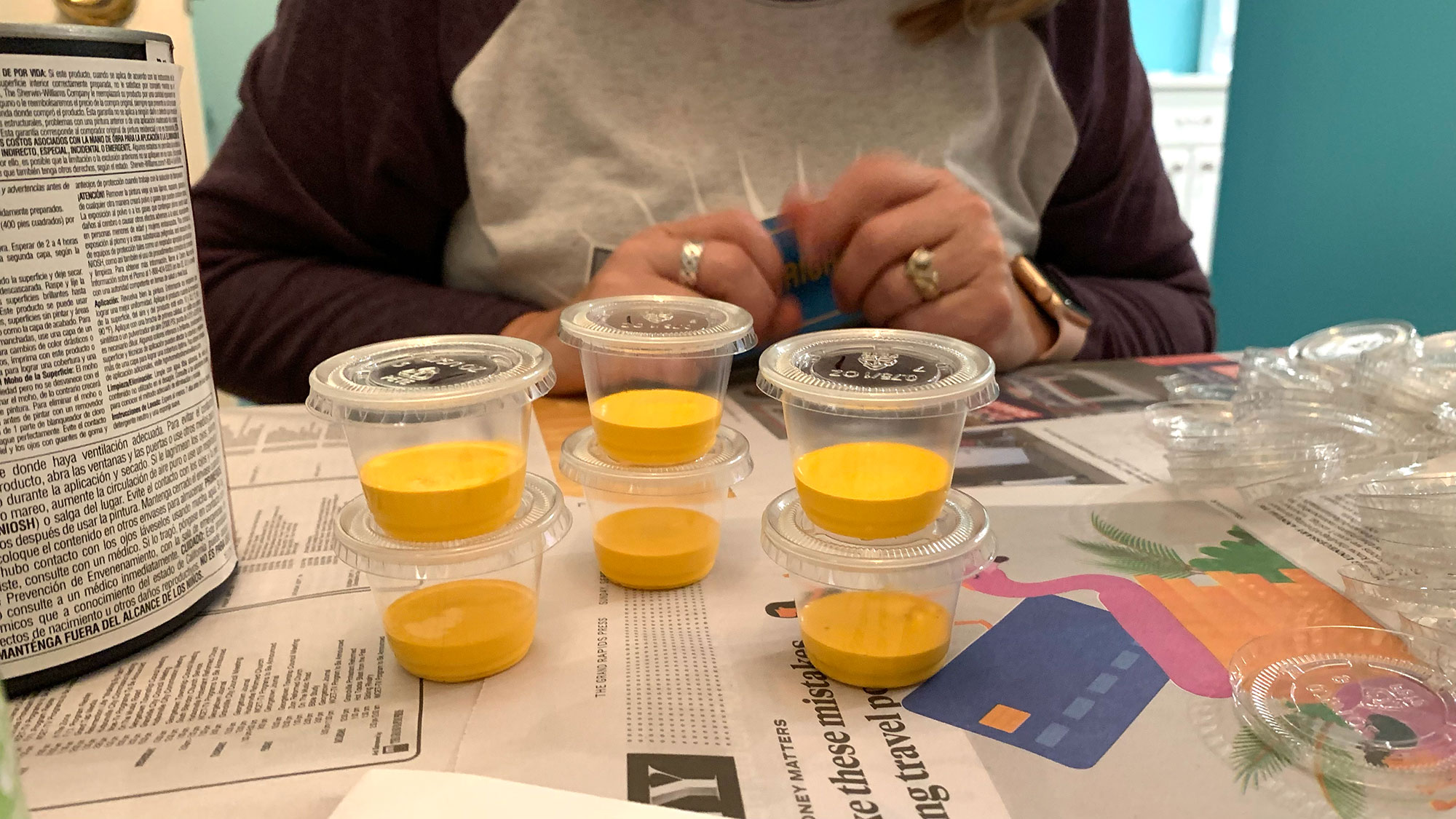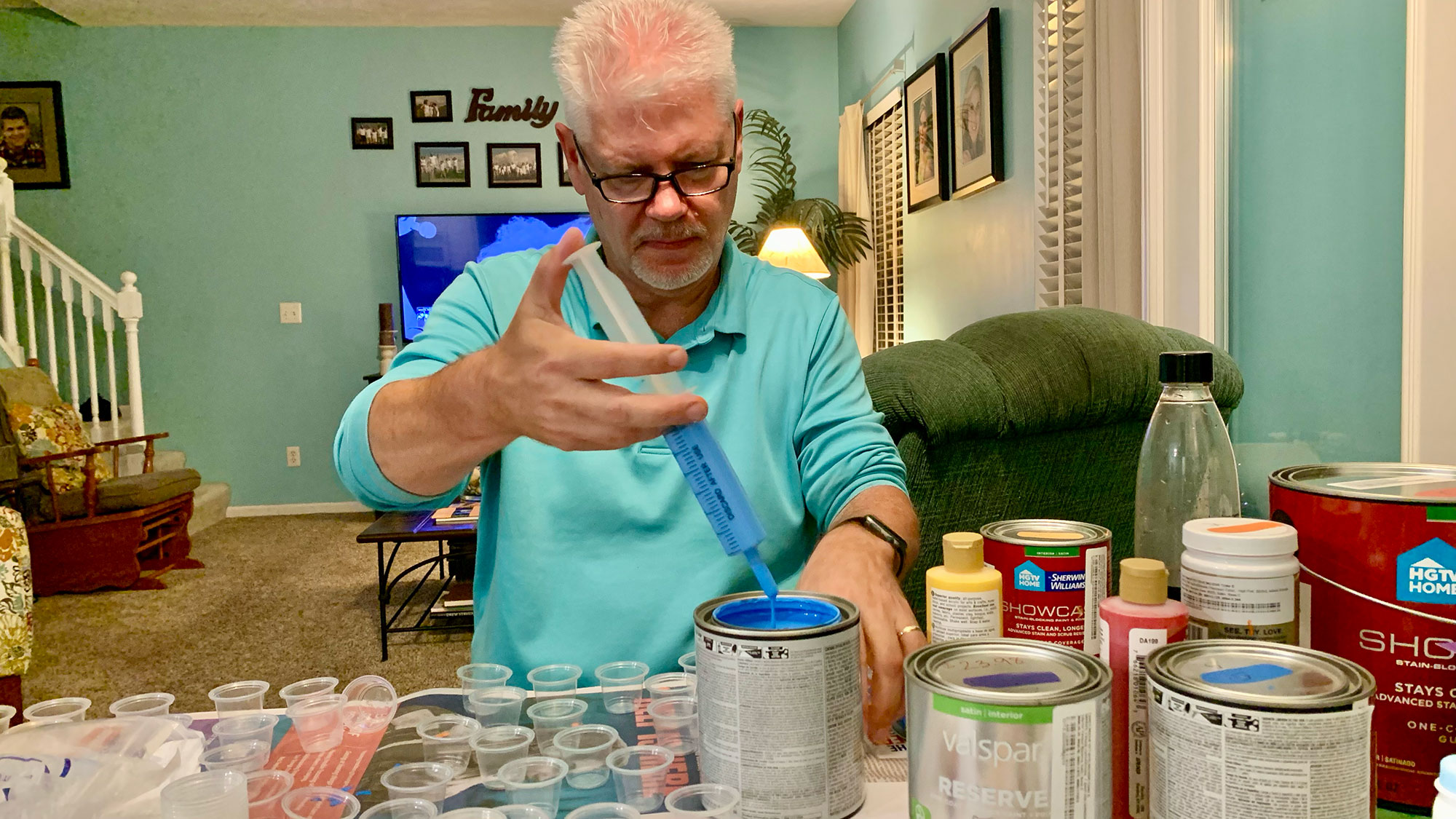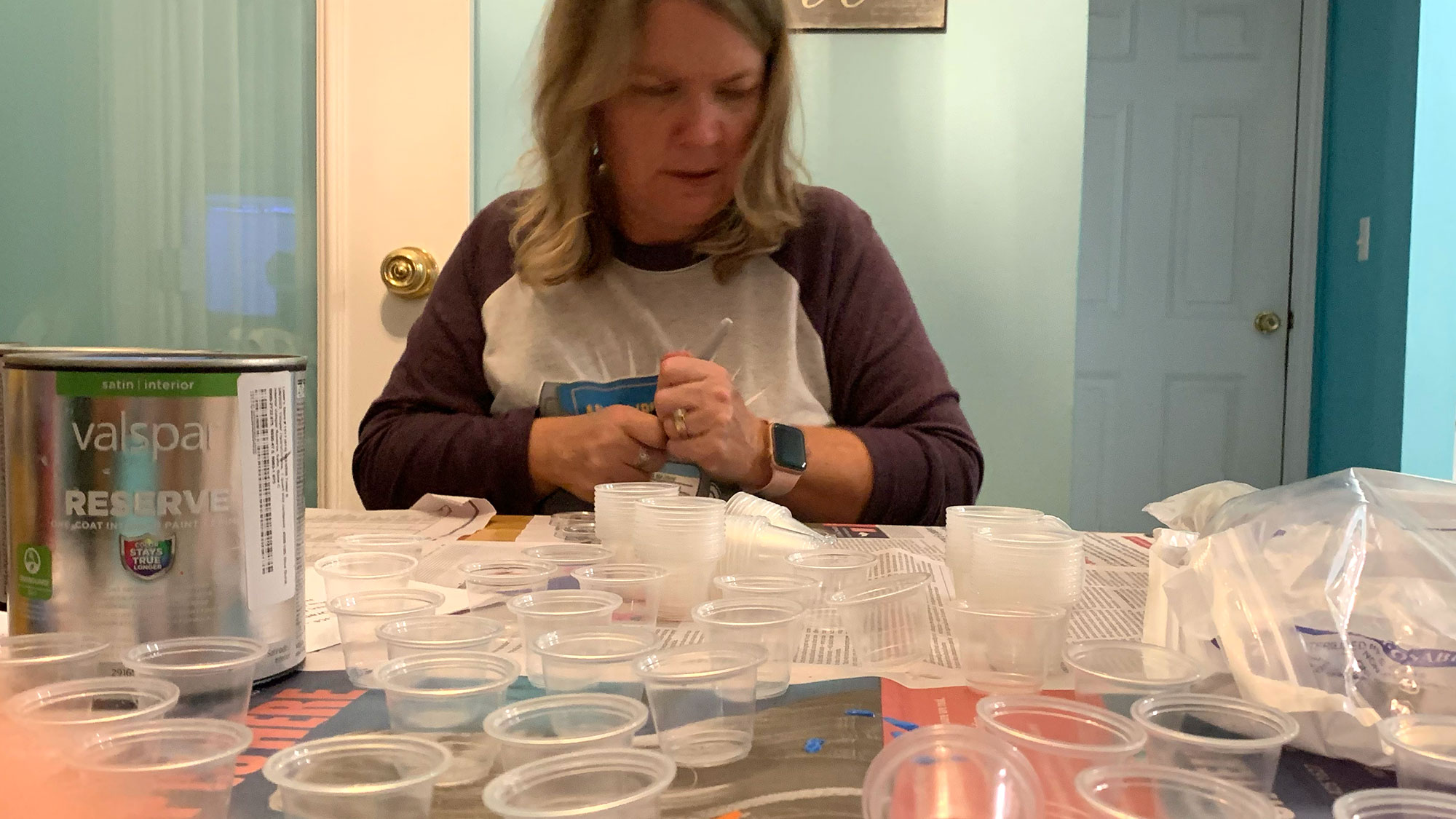Project Journal
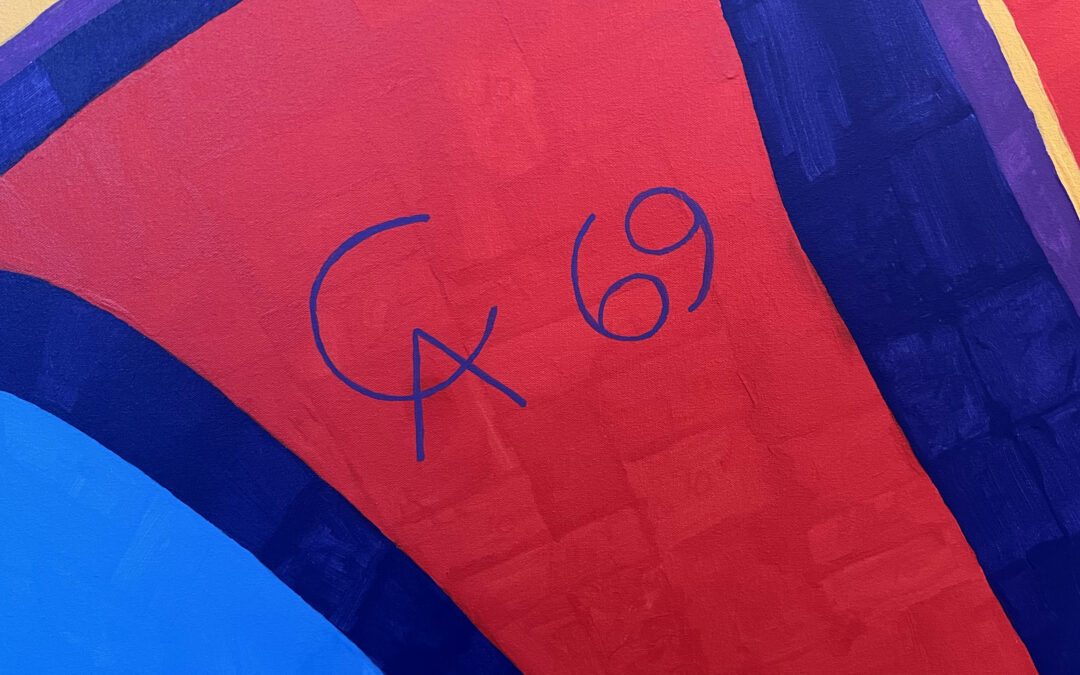
It’s back! ArtPrize 2024
After some weeks of consideration this spring, I decided to enter the painting again this year for ArtPrize 2024. This submission is in a new category this year. Last year it was a Time Based project and this year it’s a 2D project. Why enter a second year? Primarily it’s because it will give people a broader chance to see the finished canvas and learn about the unique project. It will also allow participants to see the final painting if they were unable to last year. Finally, it will allow for the possibility of someone to inquire about owning the painting. My goal for the final painting has always been for it to find a “good home”. One that allows the public to see the painting and learn about the community paint-by-number project. Perhaps a person or business will be interested in displaying the painting themselves. One thing is clear though from my participation last year: people enjoyed being a part of ArtPrize and participating themselves. In the few minutes they were able to pick a color and paint a section, they were able to add their contribution to the event. Hopefully more interactive and engaging projects will be available for ArtPrize visitors in the coming years. I have some early ideas myself for some potential projects that will allow the public to interact with the art. Stay tuned and look for The Calder at a venue in downtown Grand Rapids at ArtPrize 2024!
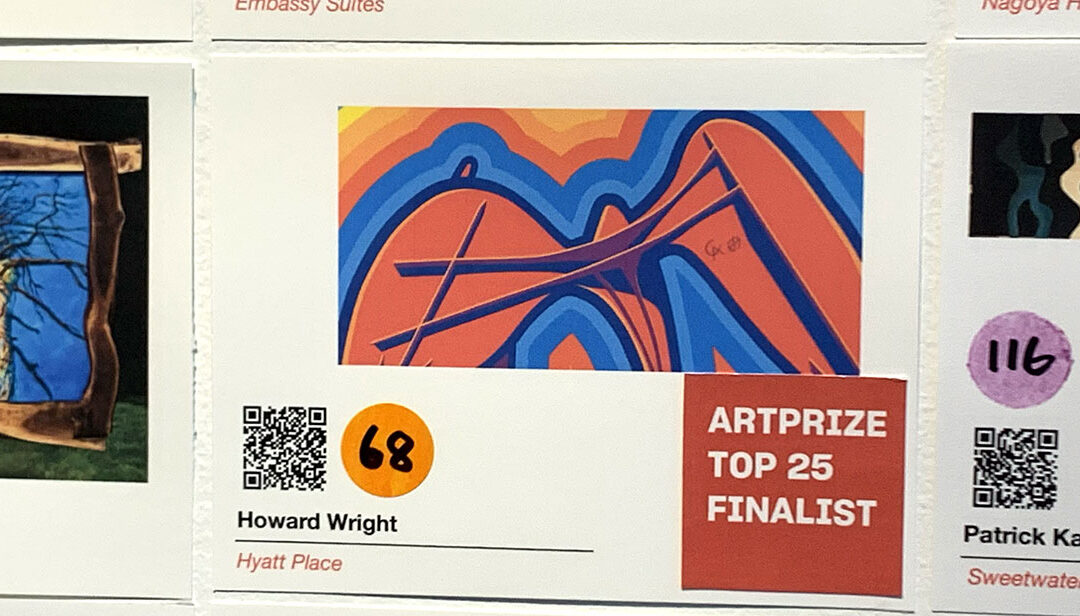
Wrap Up
Finally, the painting was done, but there was still one more week of ArtPrize. I made an effort of sitting out with the painting and chatting with curious people who passed by. Several expressed regret that they were unable to participate. Some were amazed at the process of creating it. Others marveled at the poster of faces I’d made for that last week. A few participants even made their way back to find their faces in the poster.
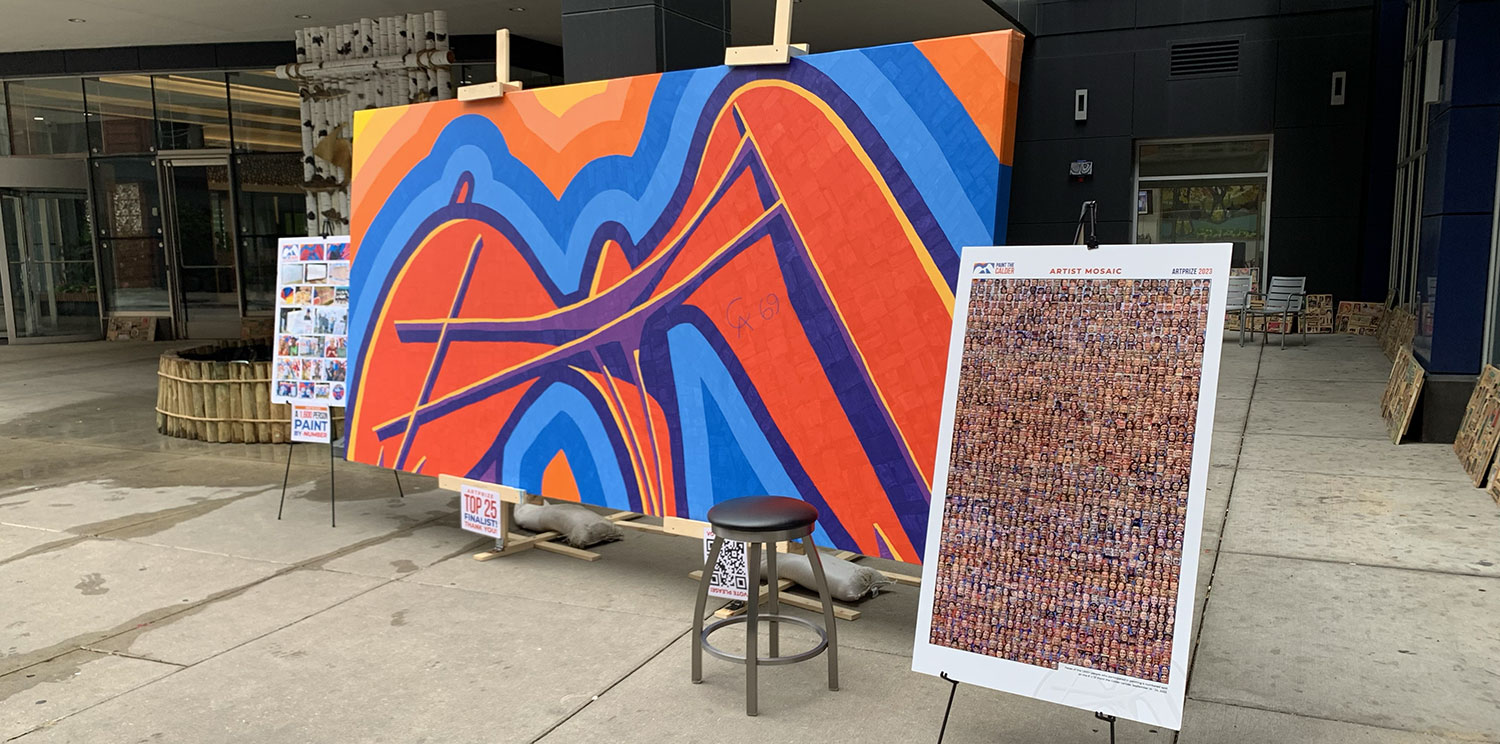
The canvas and the poster of faces sits at the Hyatt Place during the last week of ArtPrize 2023.
I was truly proud of the final painting and happily shared the story of its creation during the last week and in the months since. It was hard to contain my enthusiasm for the process and happiness for the final results. The six months of work making the project a reality were truly worth it, based on the participation of friends and family alone. To see the hundreds and hundreds of smiling faces of all who painted truly made the project a success!
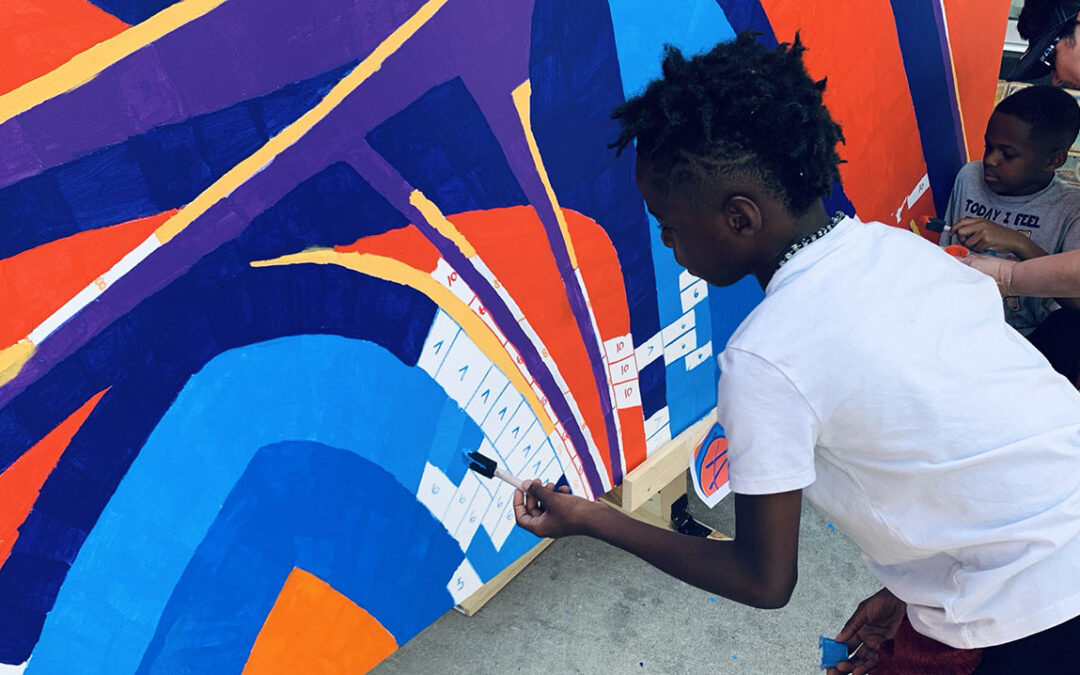
Week Two
Week two would end with the completion of the painting. Many people stopped by going into the second weekend too.

The area at the venue would frequently get busy with interested participants. Thankfully my wife and our volunteers would keep things orderly.
We were thrilled to have members from Artists Creating Together (ACT) stop by one afternoon to paint. My wife and I were able to stop by their facility the previous evening to meet some of their talented artists and to share the word about our ArtPrize project.
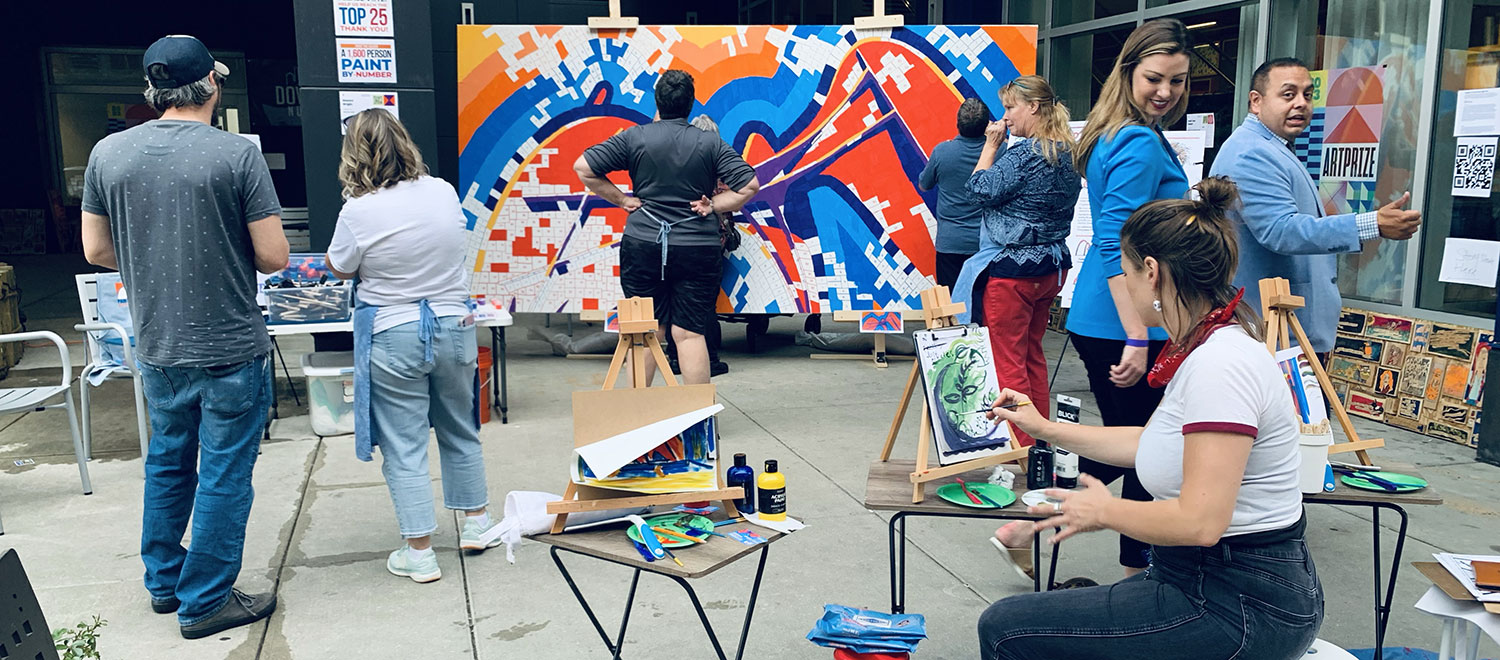
Kait Polzin, Community Arts Captain at ACT works at her easel during the second week of ArtPrize.
We watched anxiously as the canvas continued to fill in. The bold colors really stood out and it became apparent that we’d reach our goal of having the canvas completed by the end of the second week.
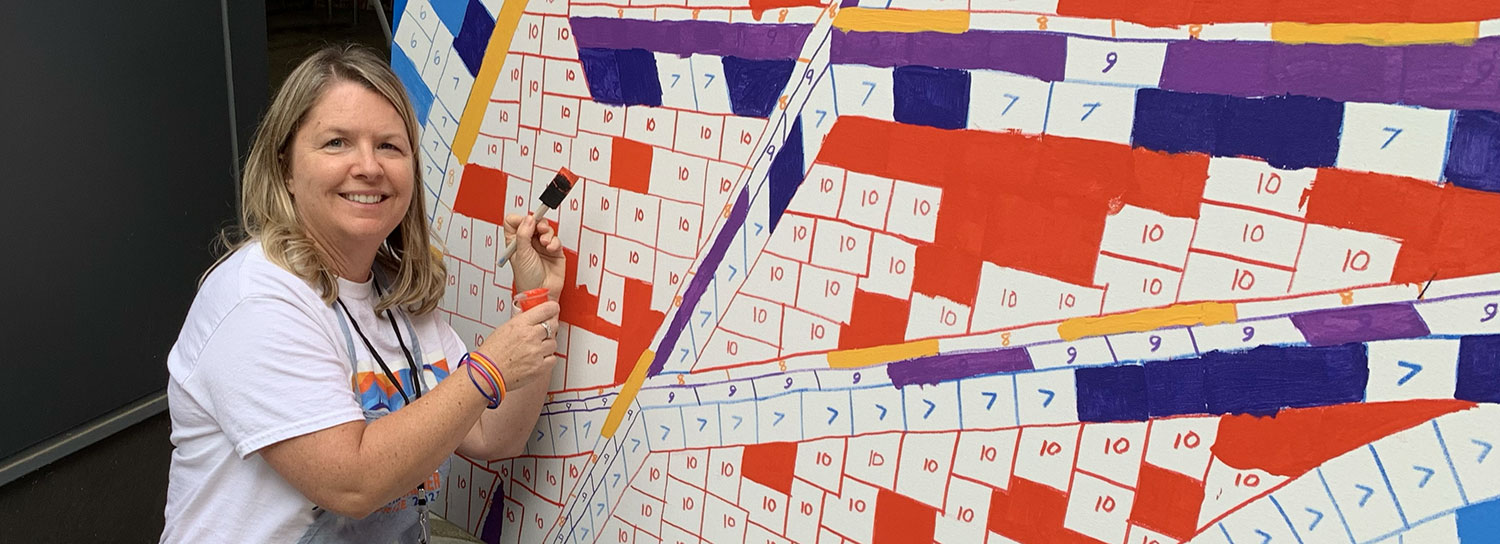
My wife Deb was an important part of the success of the project. From organizing volunteers to helping with the paint and brushes, to setting up the painting process, she always brought her enthusiasm with her.
The festive feel of the event seemed to take on another level the closer we got to the completion. The peak was likely the evening when it was announced that our project had made the Top 25! Out of over 800 submissions, Paint the Calder had become a fan favorite! News spread amongst family and friends and people stopped by having heard about it.
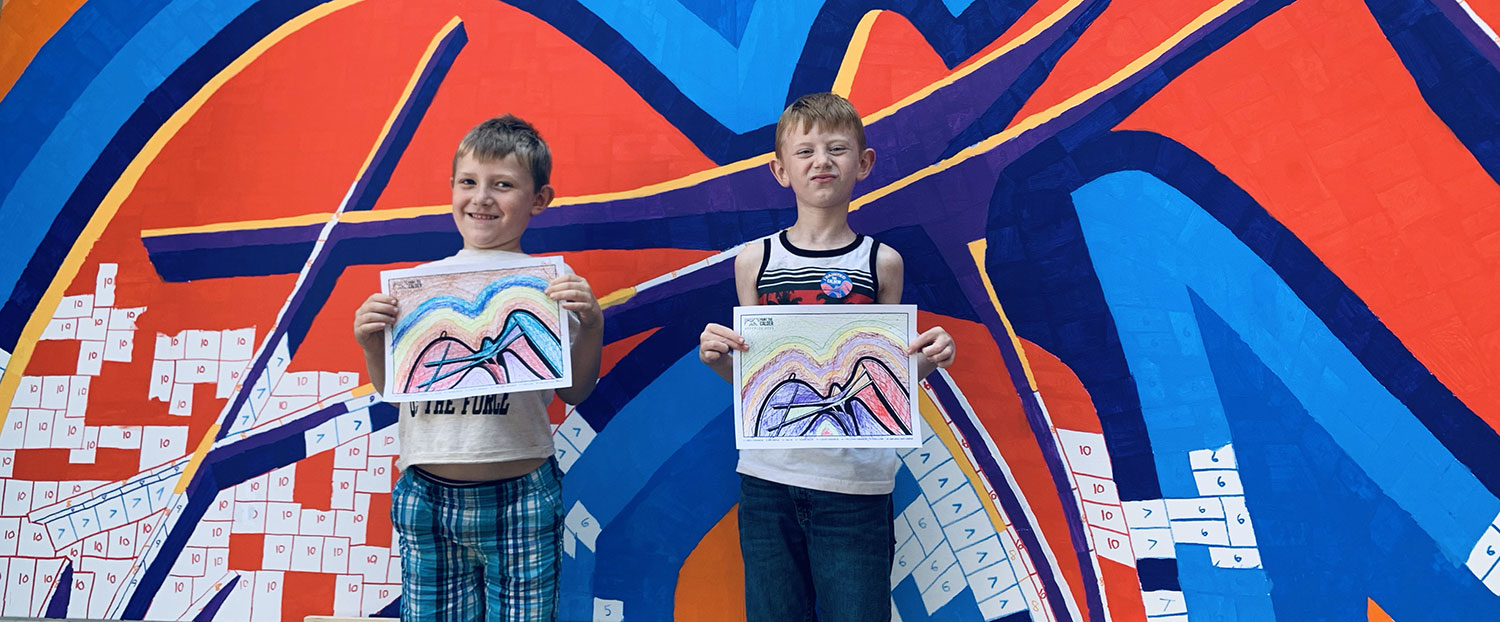
Sealy and Jayce Ballard proudly show their colored Paint the Calder sheets, which were handed out for all who wanted them.
Inclusion in the Top 25 also brought satisfaction to our volunteers who made the project possible.
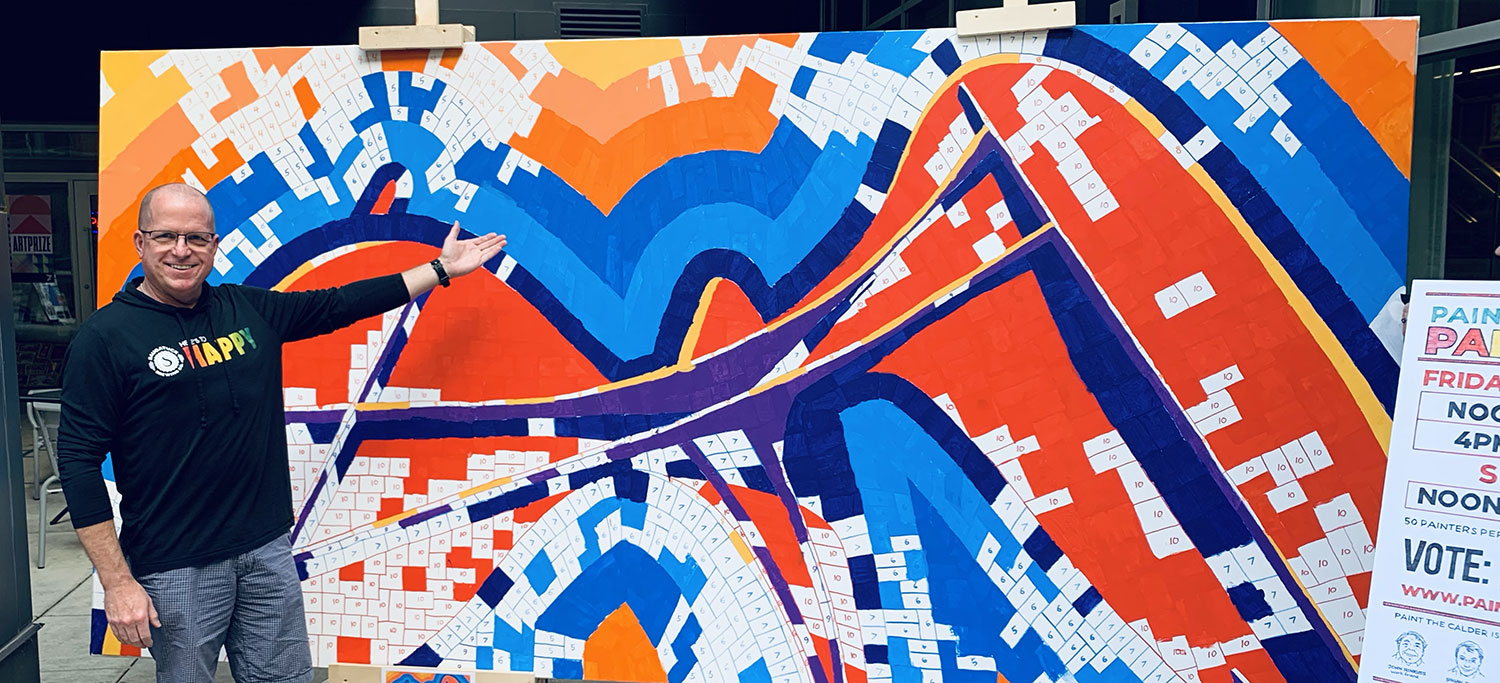
It was easy for people passing to understand the process involved once the painting and subject matter were further along.
As the week progressed and the weekend began, the amount of spaces dwindled and only upper or lower spaces remained.
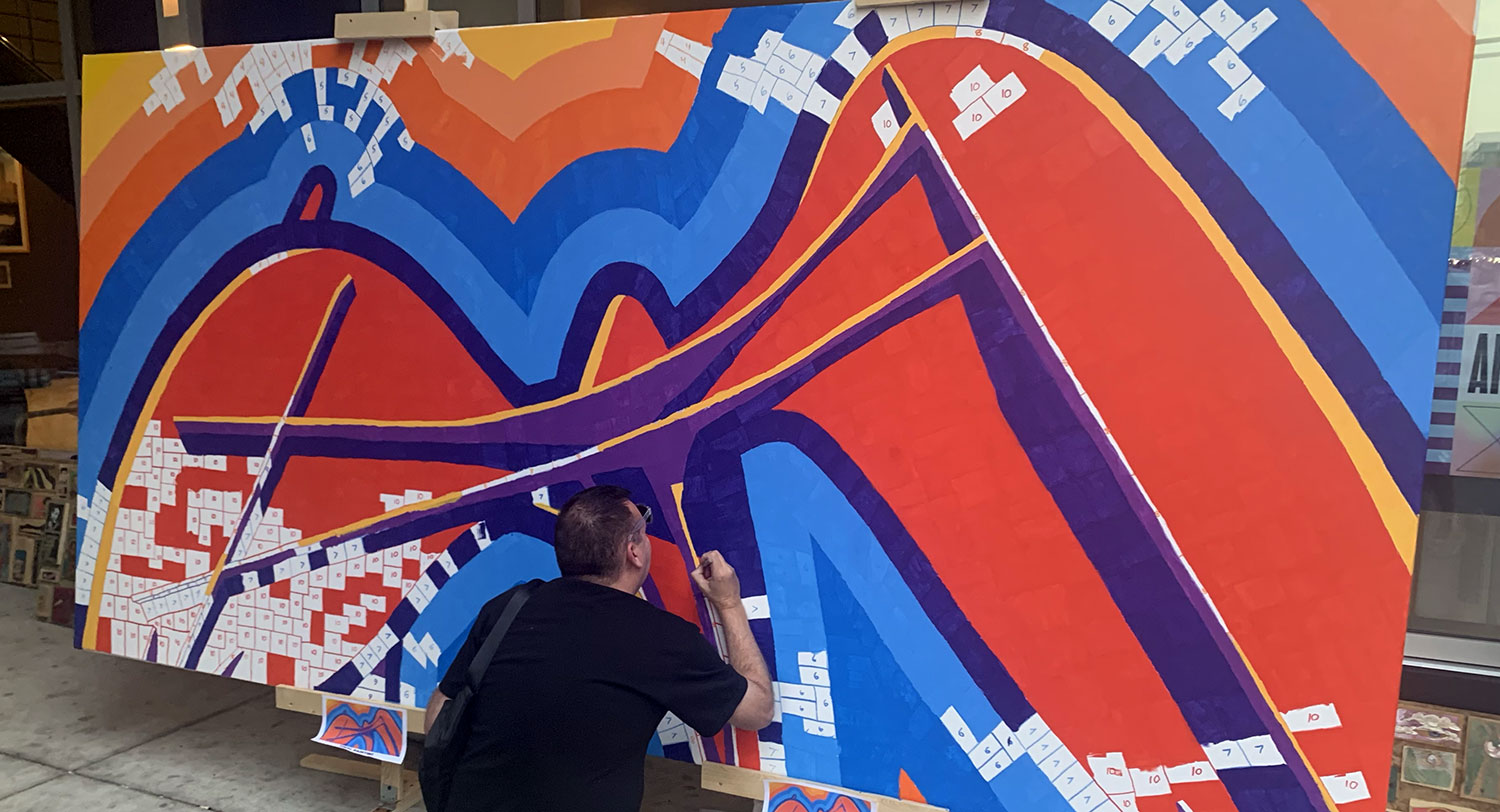
The vast middle of the canvas was completed and only lower or upper spaces remained.
The canvas became an even more popular backdrop for photos. The Top 25 publicity likely helped, as several people came looking specifically for the painting.
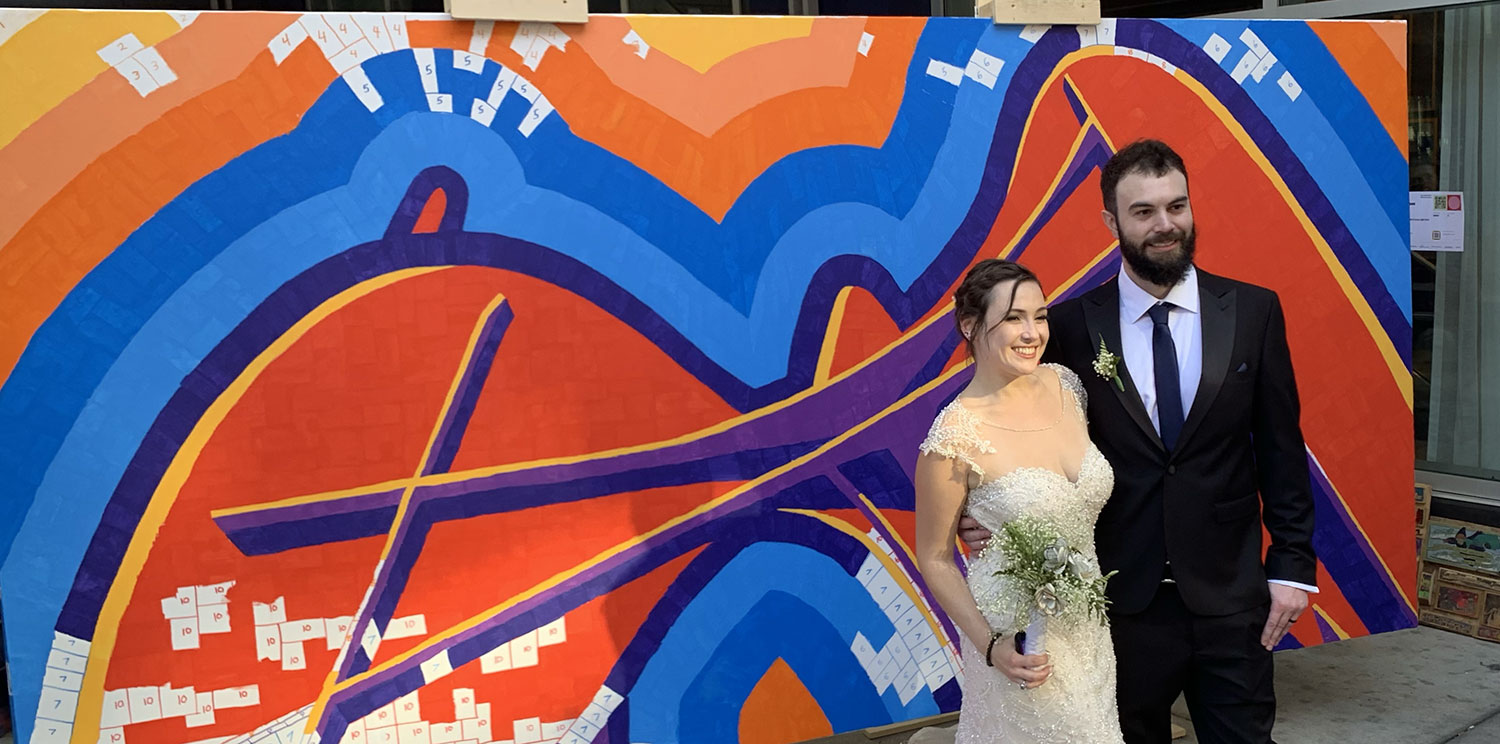
A couple pose in front of the canvas, which made for a vibrant backdrop.
As the second weekend wound down, the spots suddenly seemed reduced to only a handful. These too filled quickly as people made efforts to add their part.
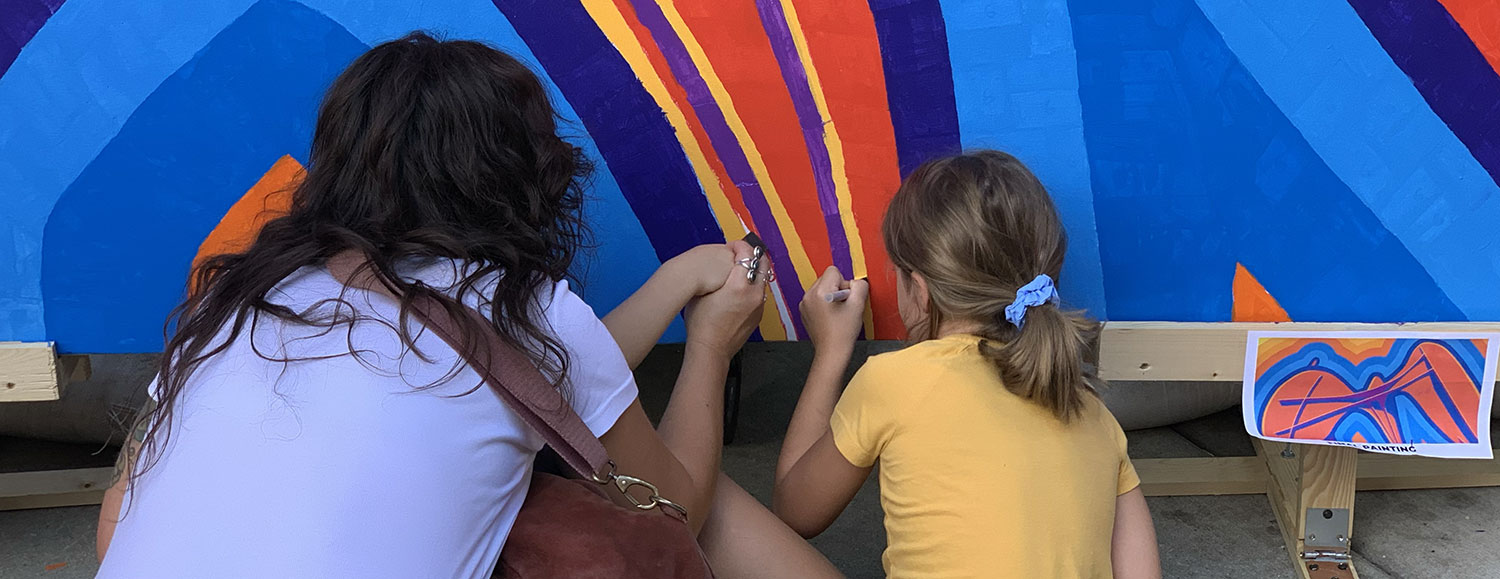
Careful painting of the final spots were all that were left, but each participant seemed to take great care in their work.
I began to make a few touch-ups and the process completed, though the evidence of the paint-by-number process is easily evident in the patchwork of shapes and numbers still visible in the colors. As a final touch, I added Alexander Calder’s signature and year of completion. This signature is visible on the actual sculpture, though less obvious than what I added to the painting.
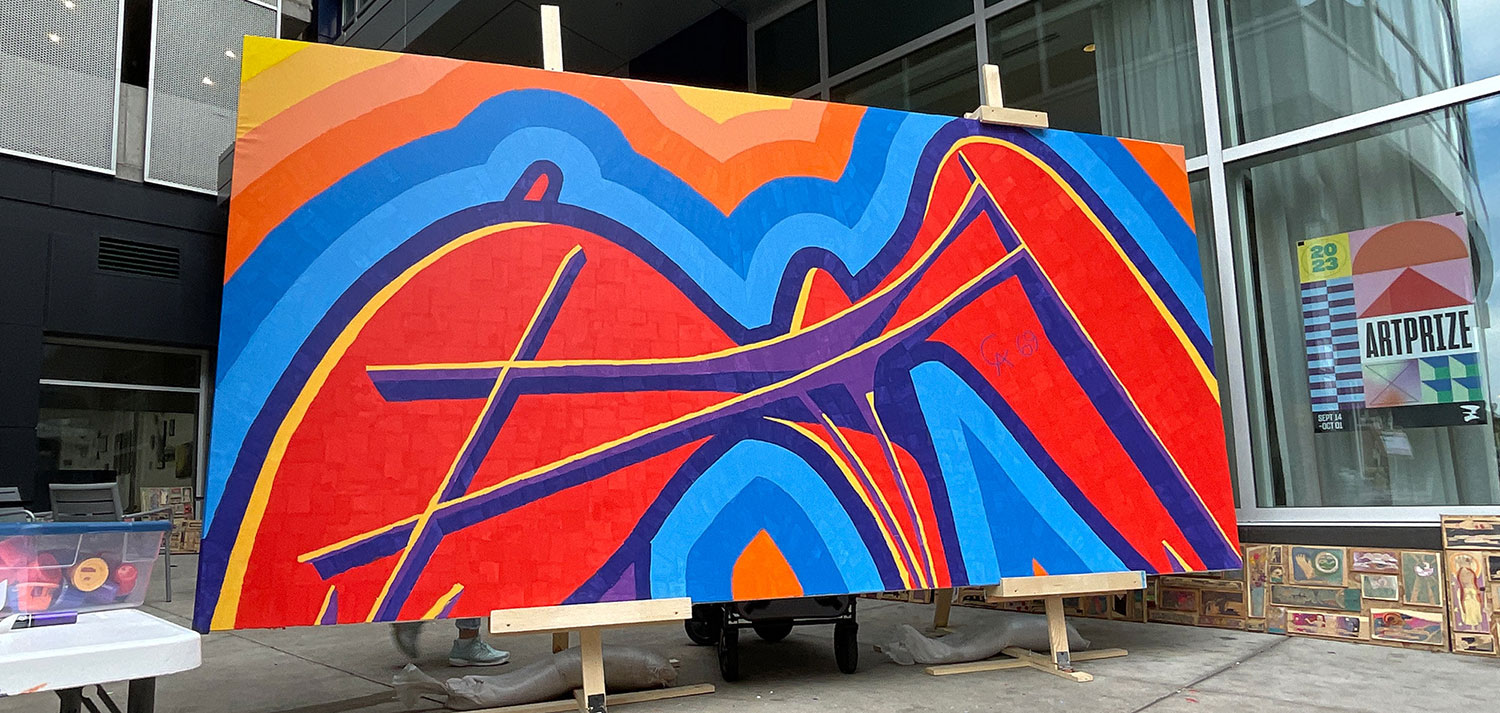
The final painting brought an equal dose of happiness and sadness that the process was over.
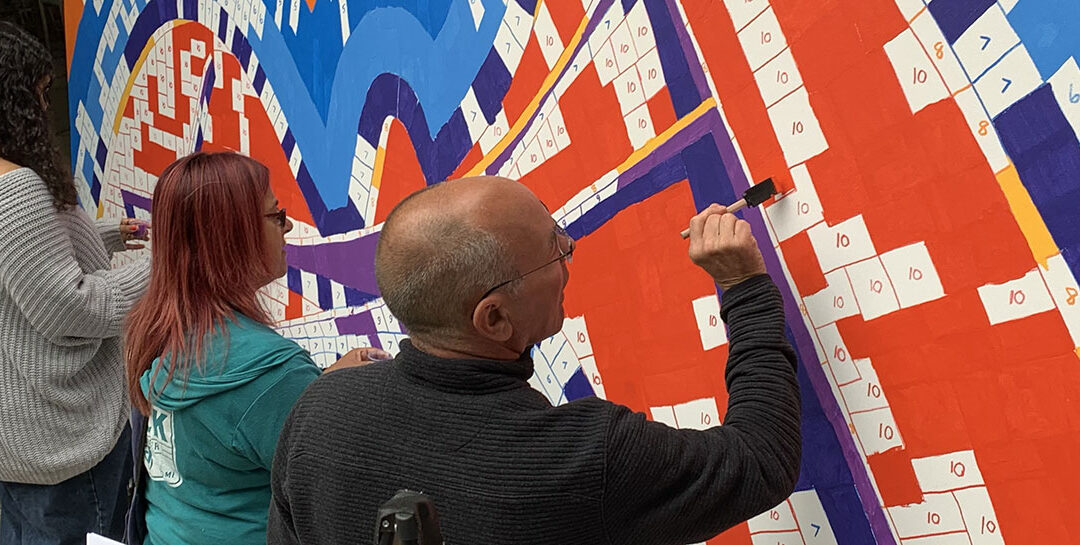
Day Four – Sunday
Sunday shaped up to be a special day. Maya Schuhknecht, Miss Michigan, greeted participants and shared her enthusiasm for art. An artist herself, she brought smiles to many who were surprised to see her greeting people passing by.
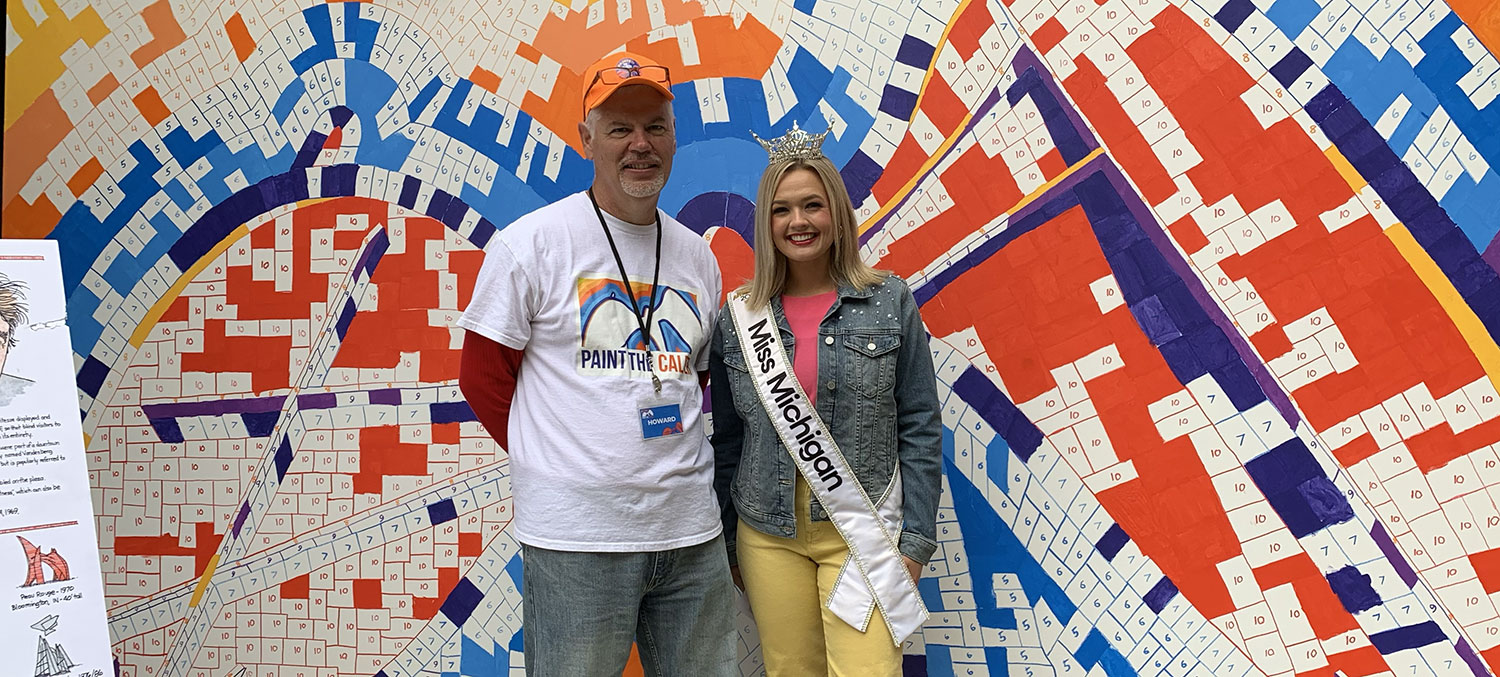
We were overjoyed to have Miss Michigan, Maya Schuhknecht, join us for a few hours.
Maya has an engaging personality and was a perfect representative of not only Miss Michigan, but for our ArtPrize project. She connected especially with young girls who noticed her tiara. She encouraged them to pick a color and paint a spot too.

Maya painted her spot on the canvas in between delighting participants.
Maya’s presence was felt by all and helped bring even more excitement to the day. We’d gotten the process of handing out paint and brushes down pretty well and the canvas was showing real progress by midday.
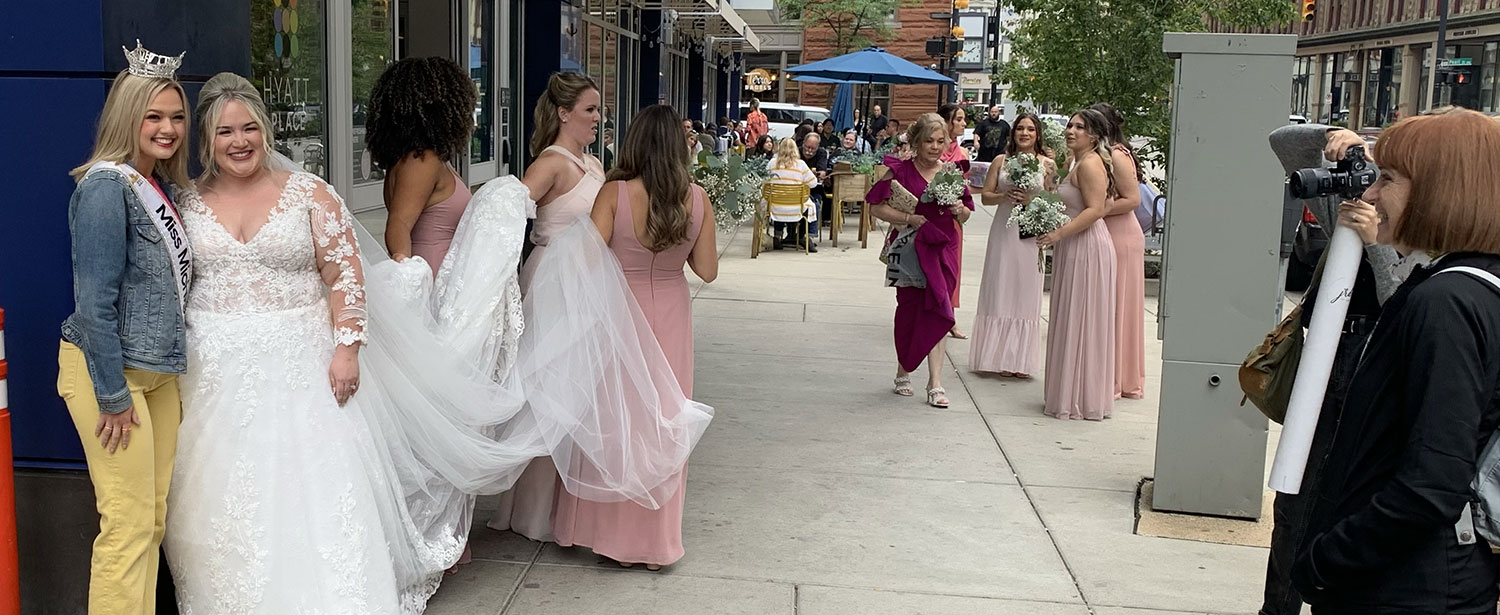
A wedding party at the Hyatt hotel noticed Miss Michigan and the bride got a quick photo with her.
We started to notice some areas of the canvas filling in quicker than others. This may have been due to the average height of the people and less effort to reach down or up. We did encourage tall painters to go up high! Lower spots were often done by younger artists.
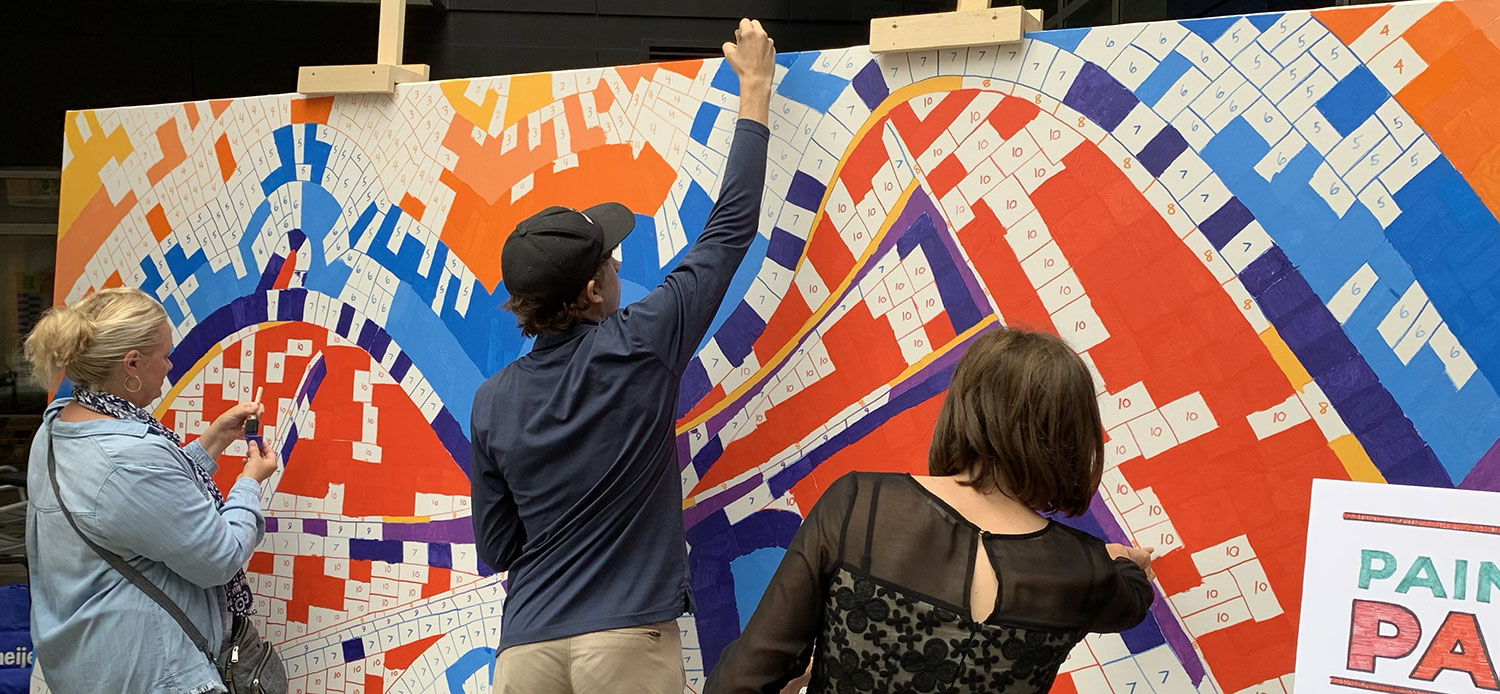
We encouraged those with height to reach up for the higher spots!
The family-friendly project quickly seemed to get more attention as Sunday wore on and a steady stream of visitors added more color to the canvas.
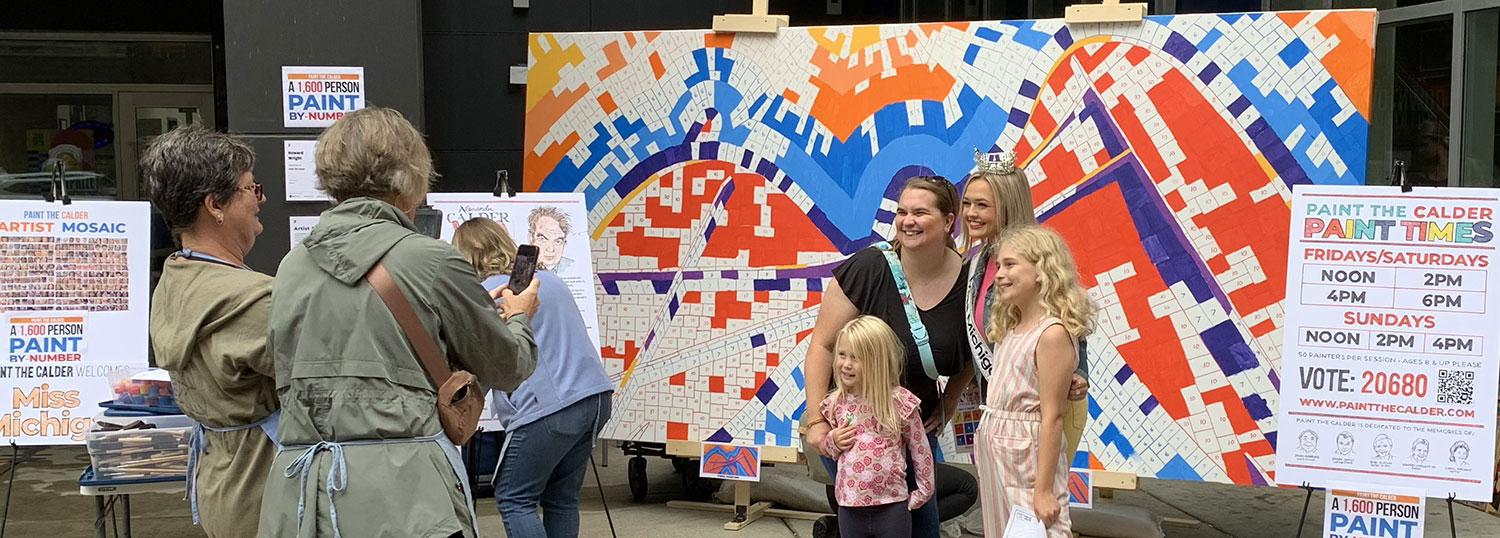
Maya takes a photo with a family while attending Paint the Calder.
We enjoyed the day and the weekend proved to be a huge success overall. We hadn’t been consistent encouraging participants to vote, since the process was a bit challenging for some. We were quite happy to see the enthusiasm from all who painted and were engaged by a project that offered them the opportunity to contribute.
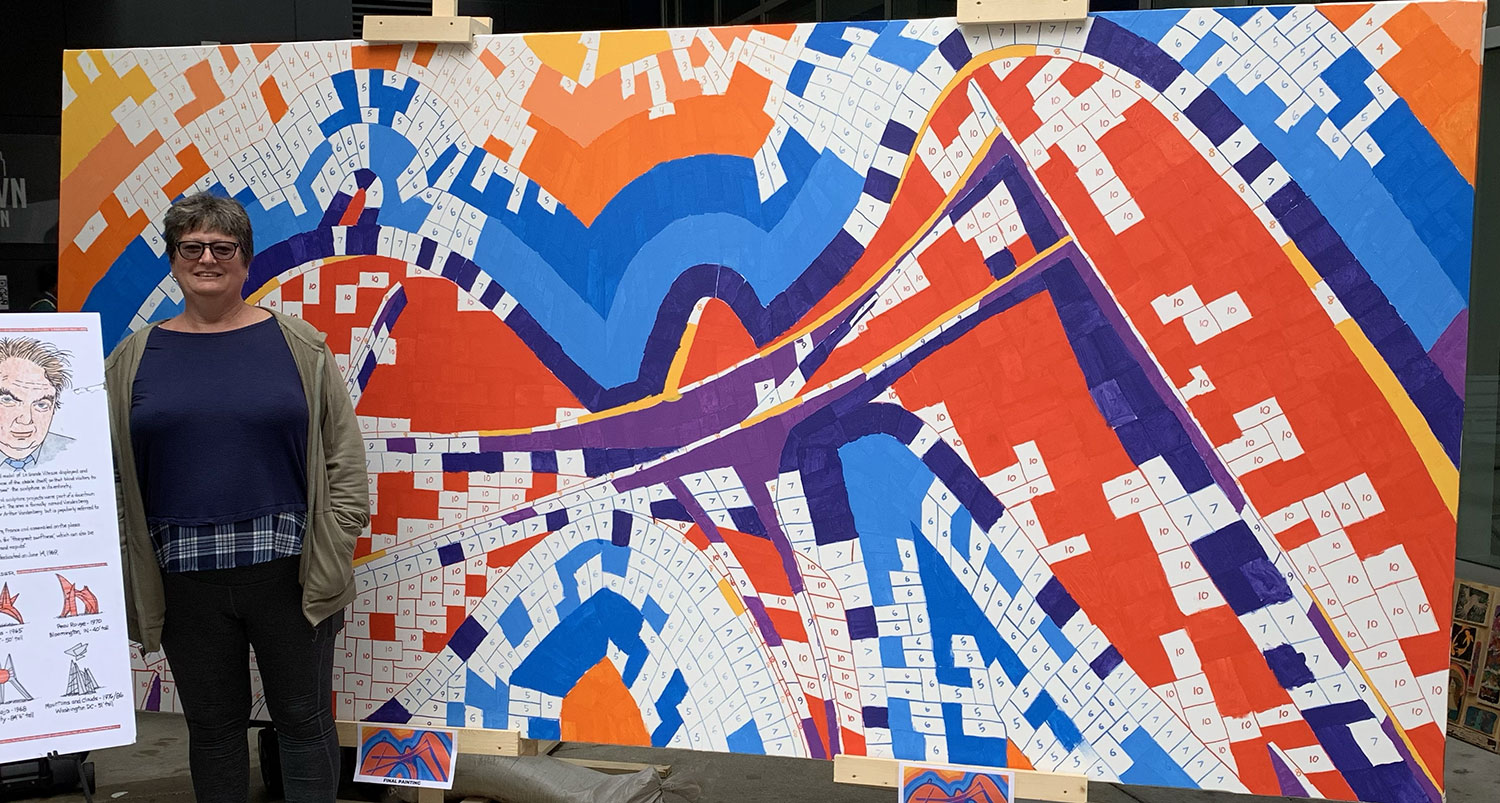
The matrix of open spaces quickly changed Sunday.
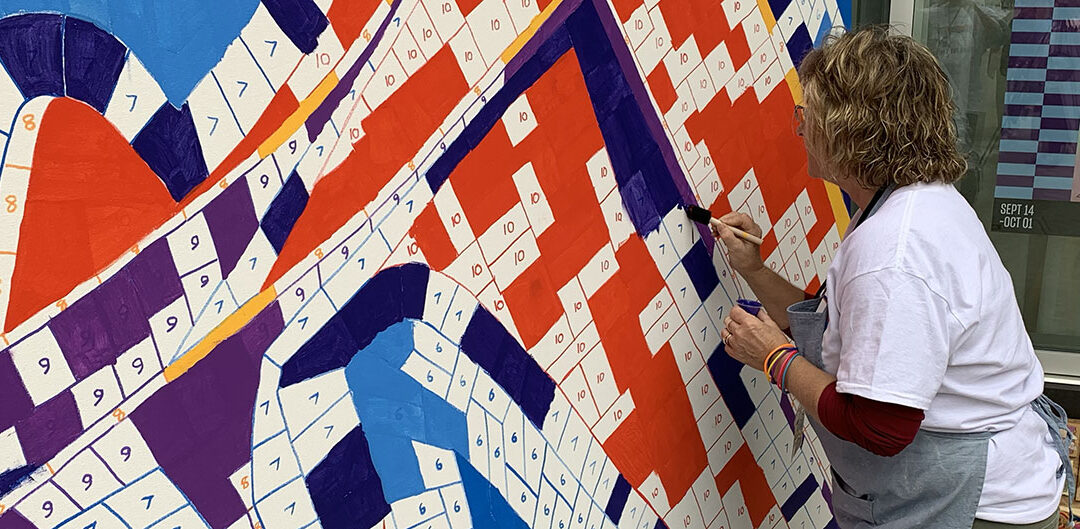
Day Three – Saturday
After a busy Friday, we knew Saturday would be busy. We were right! Thank goodness for our small army of volunteers who made the process seamless for participants and kept the wait times to a minimum.
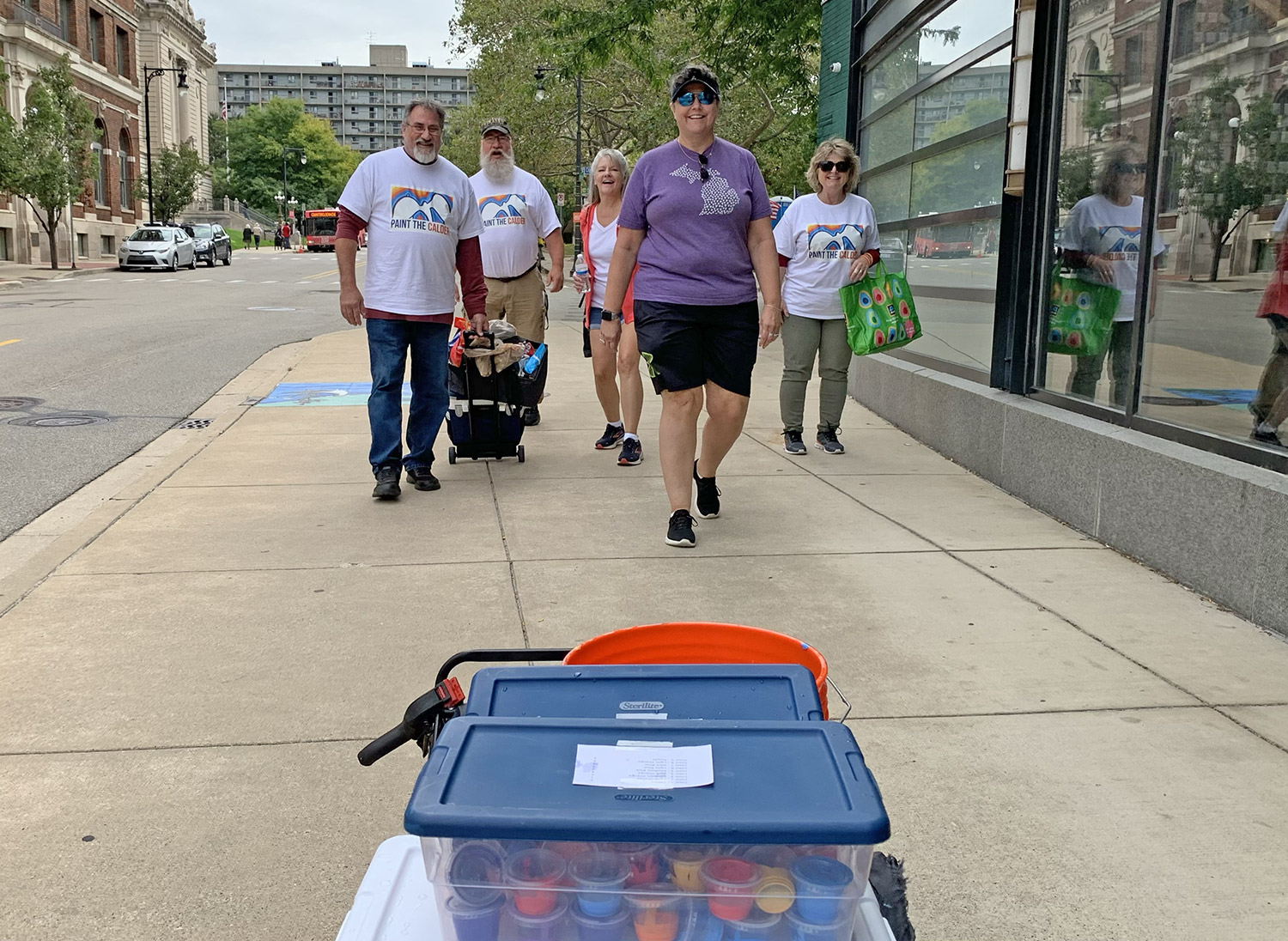
Our good friends (l to r) Matt, Brian, Kathy, Robin and Anita were in good spirits as we walked to our venue space.
With our freshly cleaned brushes from the night before, filled paint containers, and stickers, we made our daily trek to the venue. Upon arrival, the painting had to be moved from inside the Hyatt to the area outside the entrance. This was easy with help and required the canvas and both easels be repositioned outside. Fortunately, the weekend and upcoming weather forecast was favorable and we were able to get set up quickly.
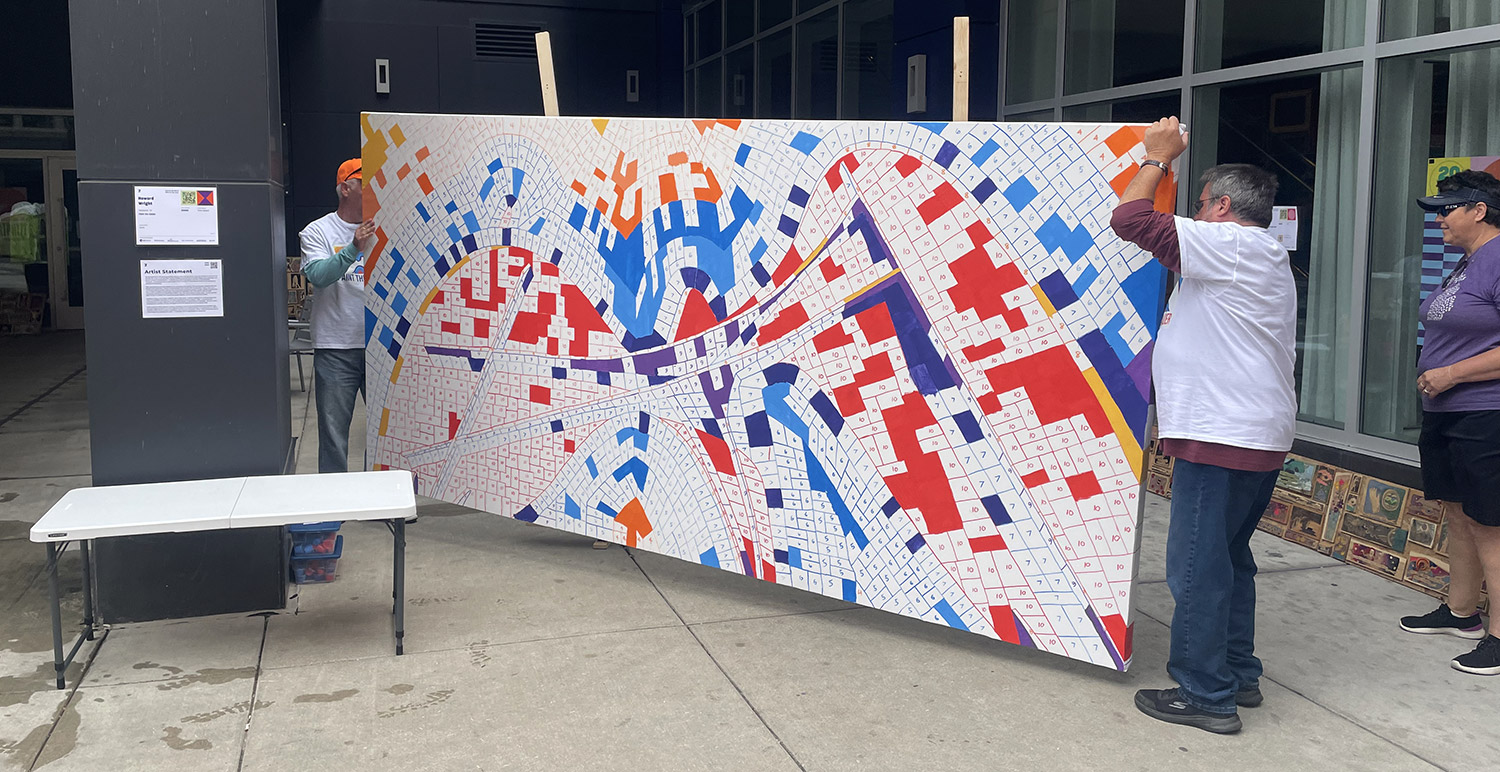
Matt and I carry the canvas from inside the Hyatt where the easels and sandbags awaited.
Since we would often have people ready to paint, we’d quickly get the supplies ready to hand out. No lines were necessary to manage, but we’d encourage people to select their paint color and begin to look for a spot to paint.
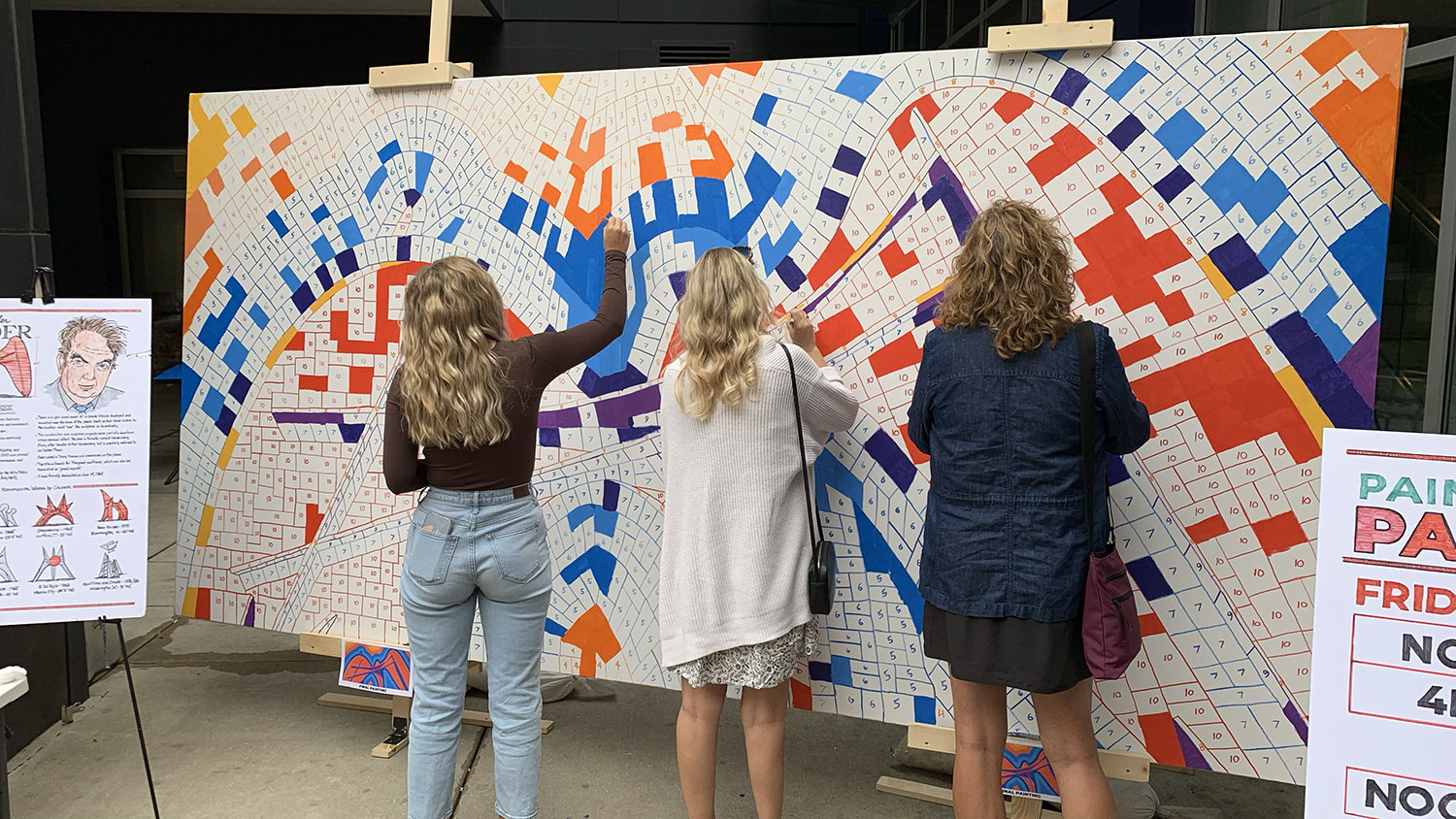
As paint began to fill in the spaces, it became more obvious what the project was about, and people would be eager to fill in their spot.
It was fun to see people approach the canvas with different plans for painting. Some would struggle with what spot to paint. Others would immediately know where they wanted to go. Some would take their time, carefully filling in their area, while others made quick work of it.
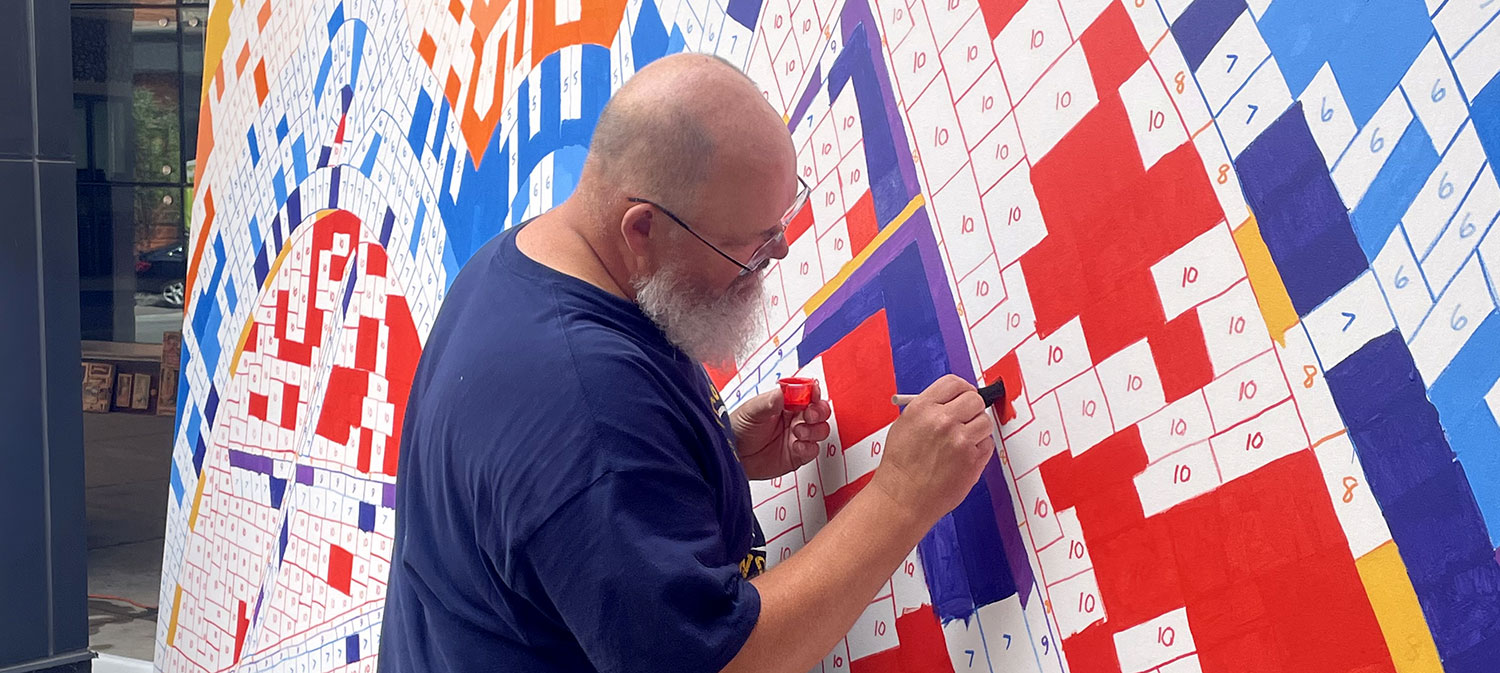
Some participants took great care to fill in their areas just right, even though the brushes could be a challenge to manage.
While many people on Thursday and Friday were workers downtown, Saturday brought more ArtPrize visitors out who were looking for art in any corner.
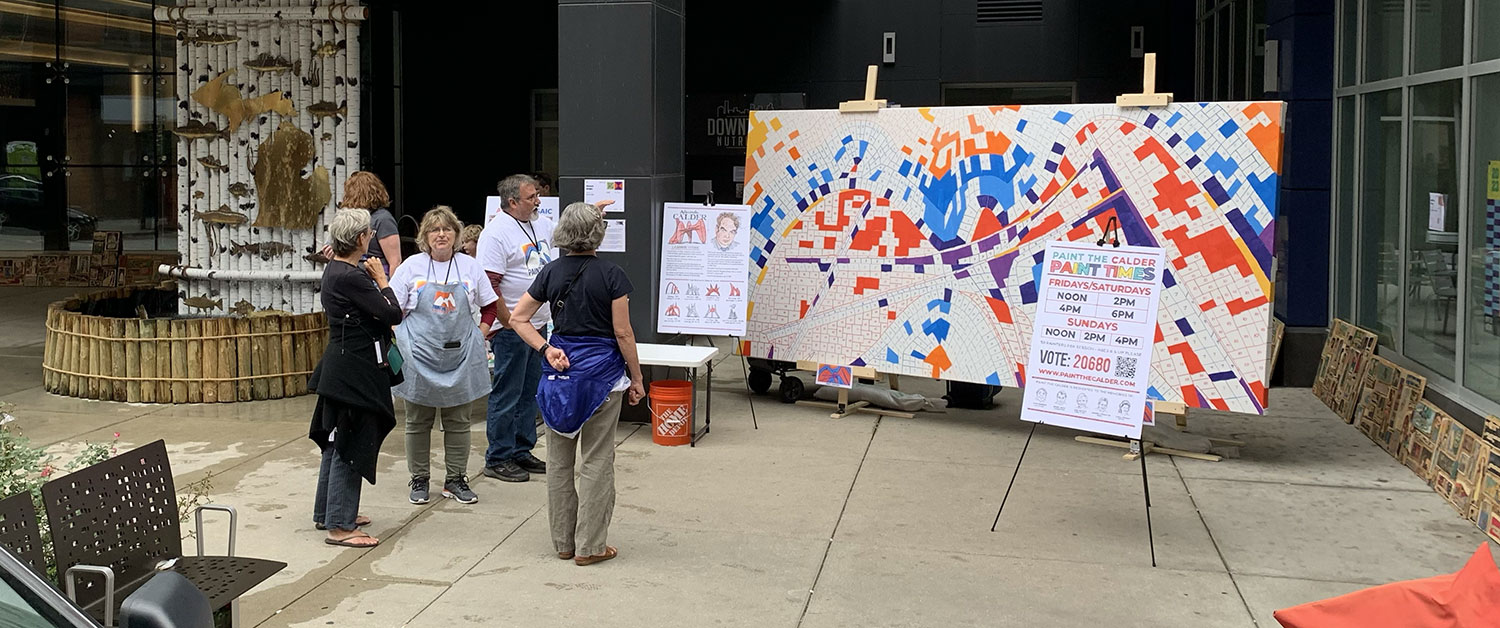
It was fun and easy to chat with people passing by. Some needed encouragement to paint while others were anxious to contribute.
As Saturday continued, we began seeing a large number of people assembling. Between handing out and retrieving brushes and paint, each participant was asked if we could take their photo for the poster.

I take photos of a couple participants while people assemble to paint. It could be challenging to catch a photo of everyone and I’m sure I missed at least 100 people over the course of the painting process.
Not only was I taking photos of the participants, it quickly became apparent that the painting made a great backdrop for photos. Many would hold up their “I Painted the Calder” stickers as proud proof of their participation.

Two friends proudly display the stickers they received for participating.
The project would have been so much more difficult without the generous help from our friends who donned aprons and helped participants with their paint and brushes. We were able to fill the full two weeks of time with volunteers who’d greet people and encourage shy ones to select a color.
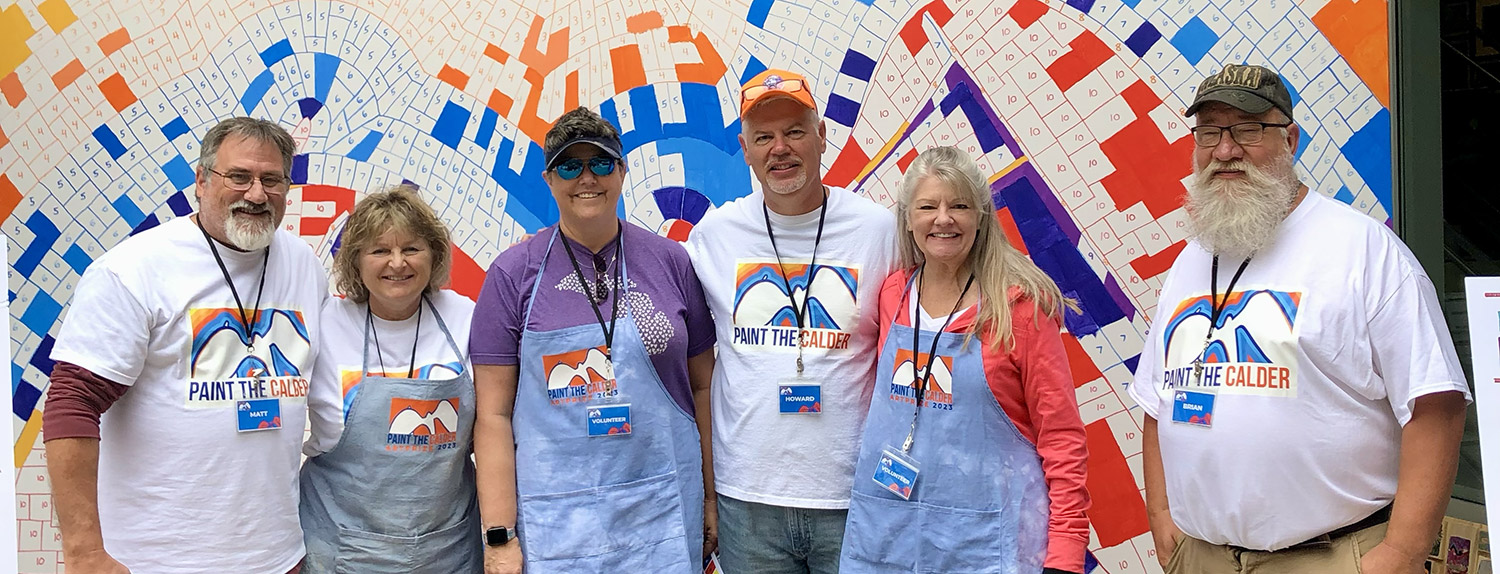
Our good friends made the process so much more enjoyable and festive. We ended up having a couple dozen volunteers over the two weeks of painting.
Painters of all ages were encourage to paint. Some required a bit of help from an adult, but all enjoyed the process.
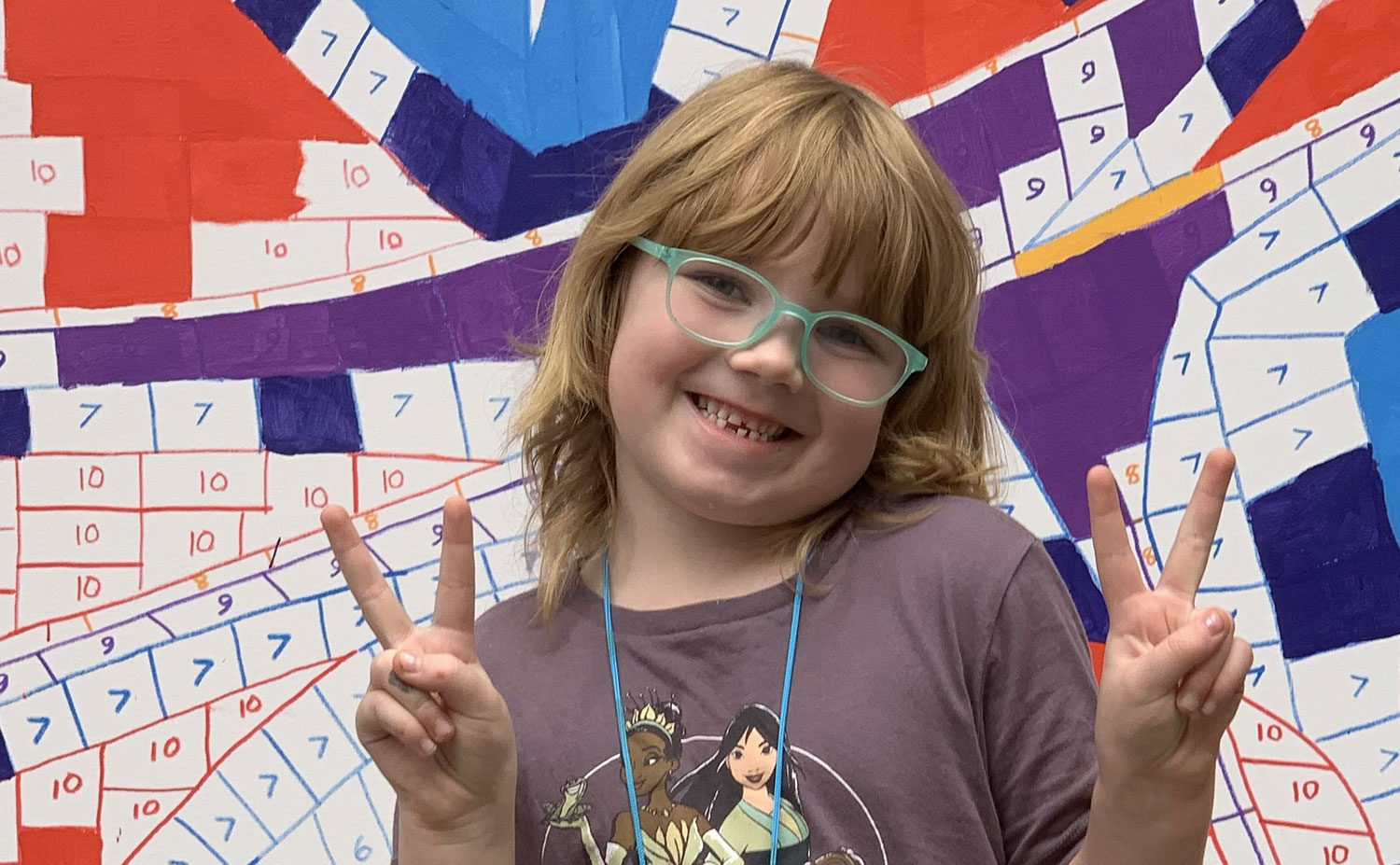
This adorable young artist quickly caught our attention shared her enthusiasm for the project.
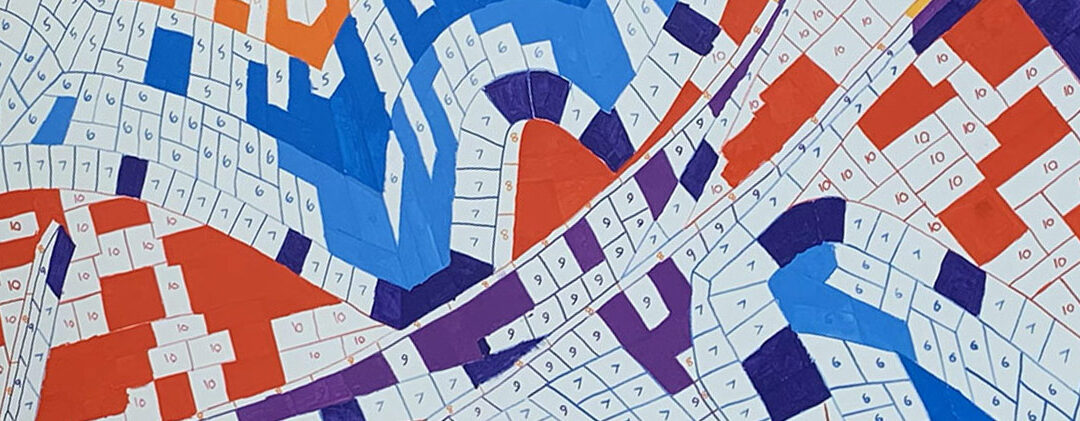
Day Two – First Friday
After a successful first evening, we had the process down with regard to handing out paint and getting a photo of each face. We’d gotten in the habit of washing the day’s used brushes in the evening but had enough initially to last for a full day (bin of new, clean brushes shown below). We used a bucket with water to hold the used brushes and it quickly became a reddish-colored soup after a couple painting sessions. We’d wash the brushes that evening in our kitchen sink while not worrying terribly about their condition (see below). These cheap foam brushes weren’t expected to hold up well anyway, although I would sometimes use a scissors to trim off a fuzzy or rough edge on the brushes to create a better edge for painting. We’d then lay them out on our kitchen counter to dry overnight.
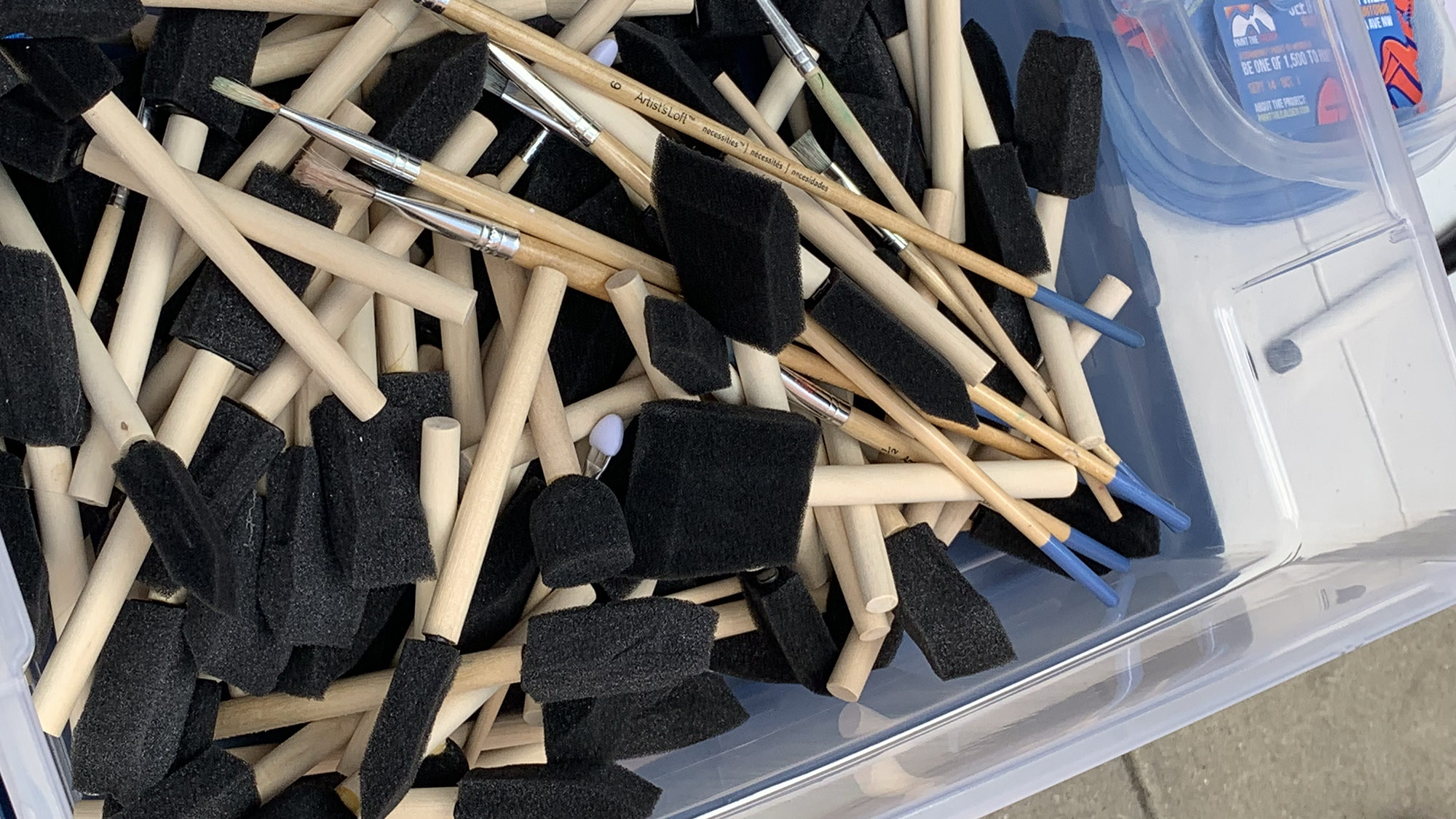

Things started a bit slower on Friday, after the big rush of people during the kickoff the previous evening. We developed a practice of not bugging people to participate. There were the obvious people who were looking for ArtPrize entries, and others who were not. It was pretty easy to identify the two types, though some people would show a bit of interest and require a bit of prodding to step forward and choose a color.
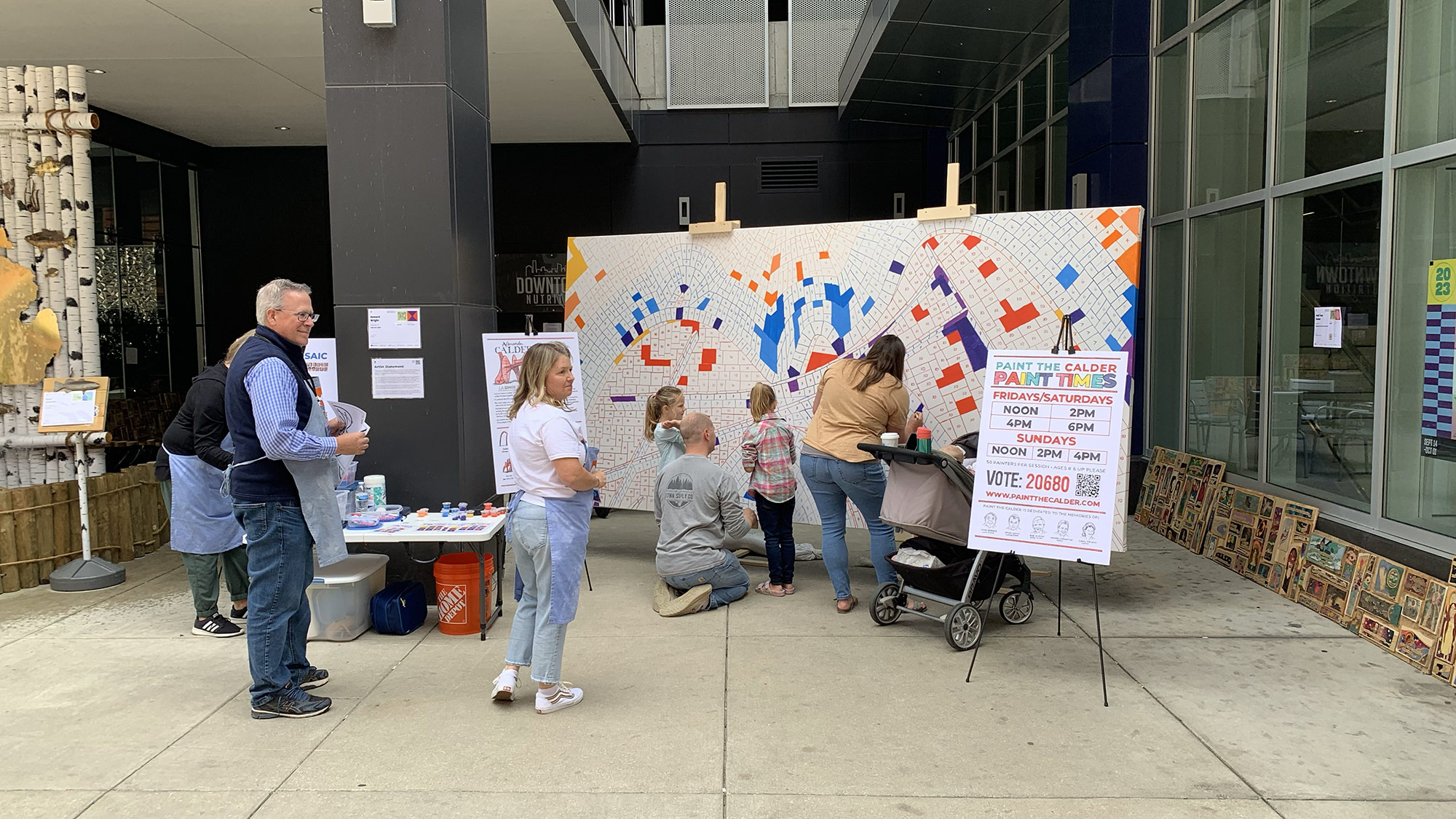
I was guilty a few times of getting distracted in conversation when I should have been taking photos of people, so odds are I missed capturing the faces of a few painters. I tried to point out the need for people to vote for us, but didn’t want to nag too much. A few people were proactive with the voting but most just enjoyed painting. While I thought a minimum age restriction would be wise initially, I removed it and just made sure parents were asked to assist their young children.
The pace picked up as that Friday went on. It was great to see people getting excited by painting (or maybe just getting a free sticker!). Some groups were likely work associates out for lunch, but the painting made a nice background for group photos.
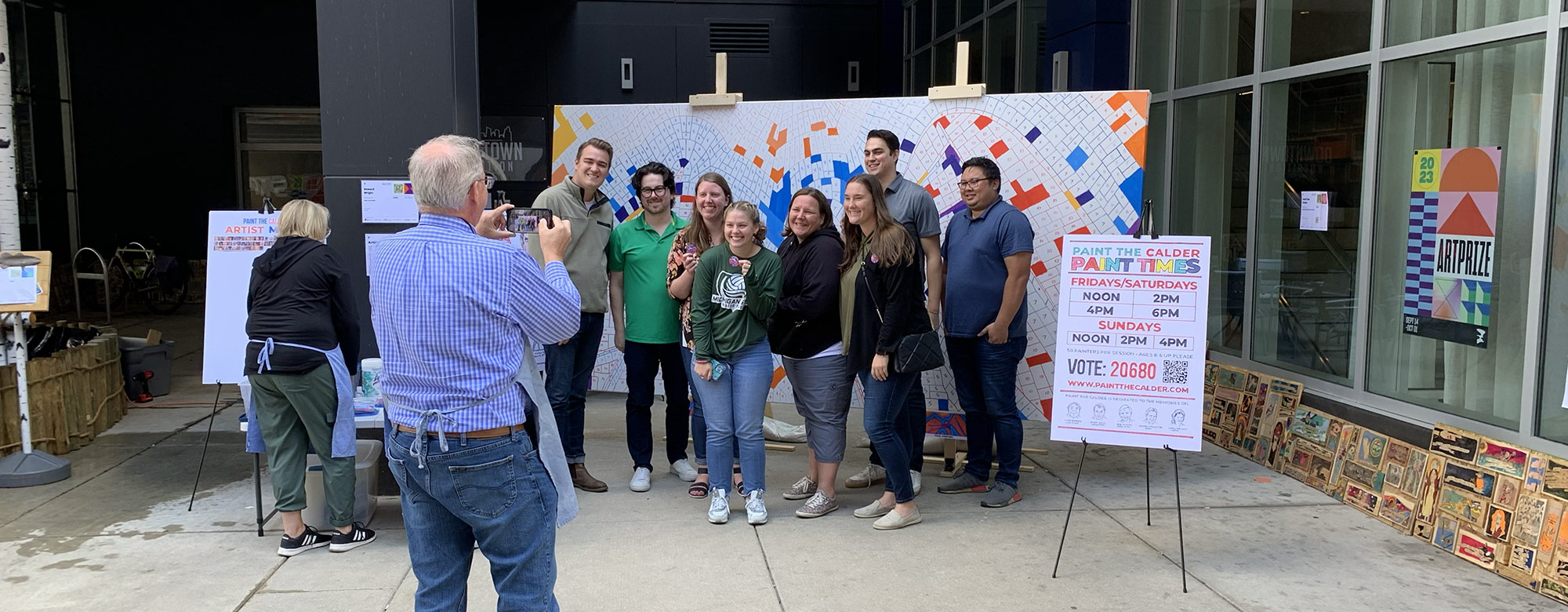
One of the first surprises we encountered was trying to control the number of people painting at the same time. The canvas was large enough to allow 4-6 people space to paint, but there were times we had to slow people down a bit and allow people to finish. Fortunately no disasters occurred where paint got spilled on a follow painter.
We also were surprised to see that several people didn’t get the message to paint only one space! I watch as some quickly started a second or third space and had to be reminded to only do one. Early on it wasn’t much of an issue, but as the spots began to fill, we had to communicate things more clearly. Everyone was very respectable with the paint, brushes and cups. It was interesting to see some people take their time and be very careful, while others did it quickly and with little effort.
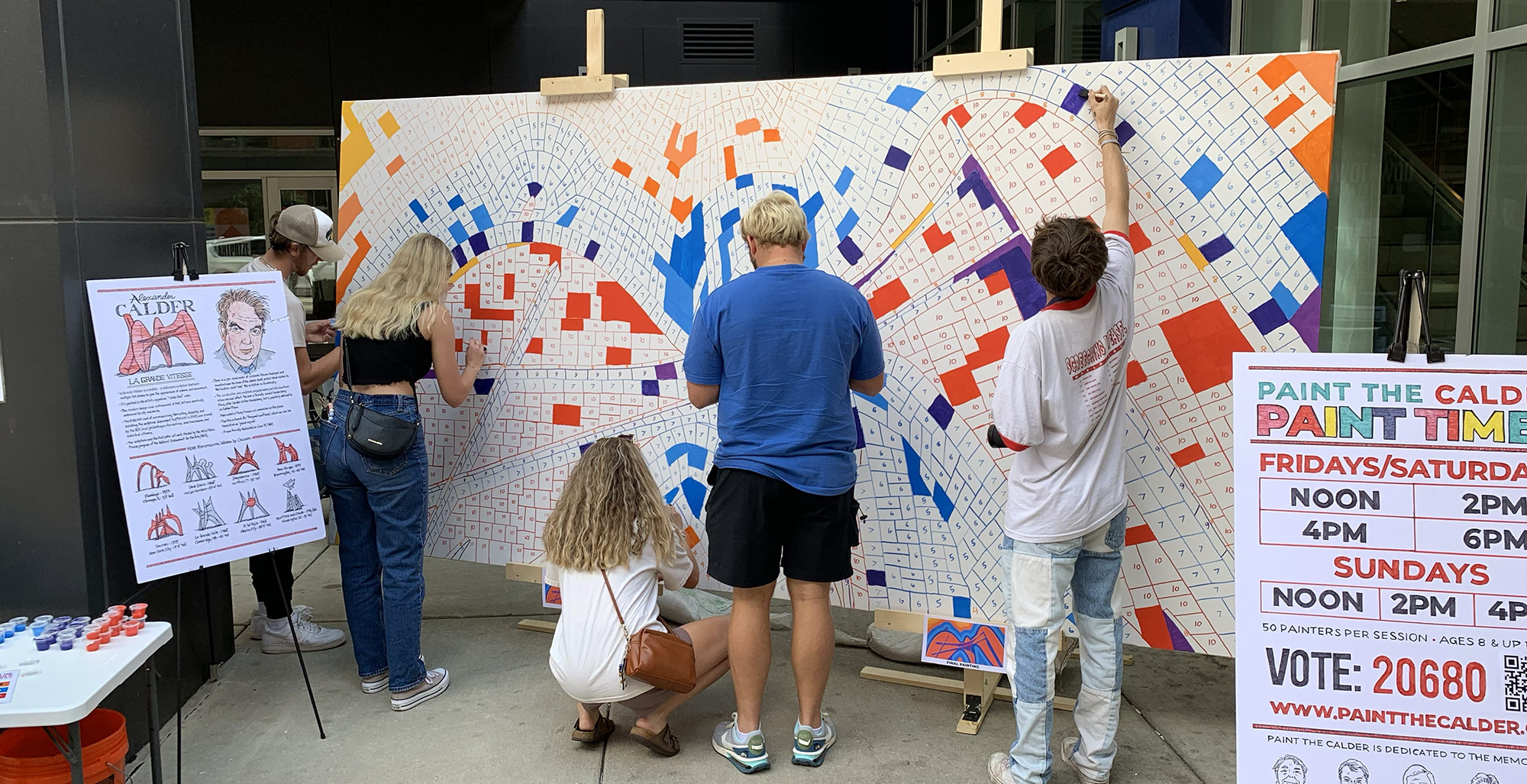
By the end of day two, the canvas was still quite abstract in appearance, which better drew the curiosity of people passing. We’d made it through our first full day, with the craziness of Saturday and Sunday to follow!
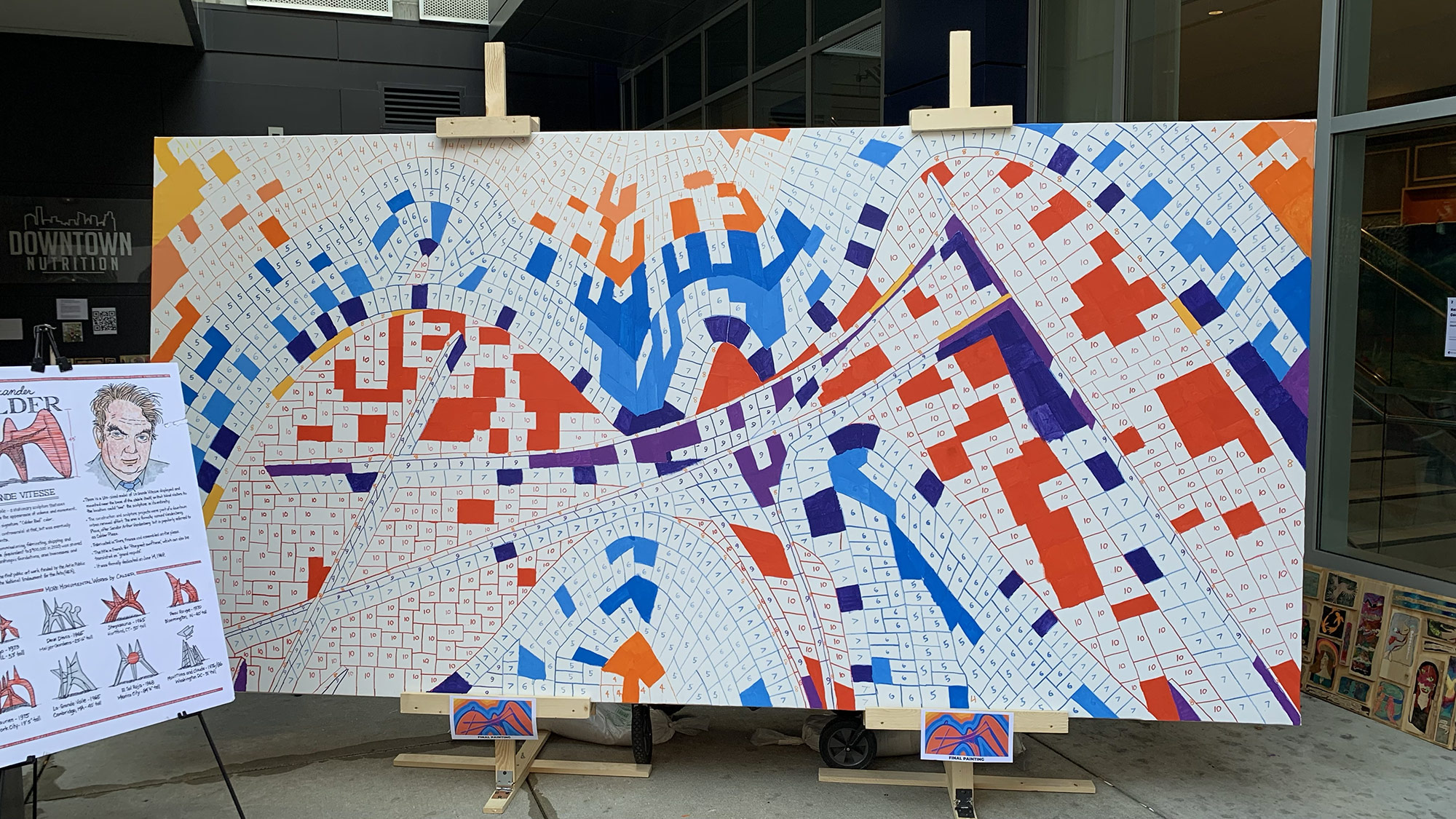
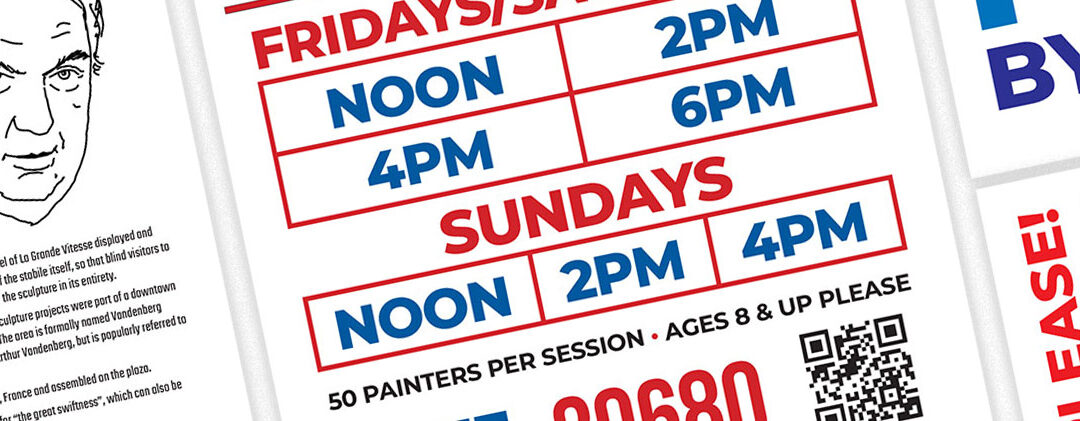
A Need for Signage
One of my first realizations after day one was the need to communicate clearer and quicker about the project. The first things I added were two small print-outs of what the final painting was going to look like. During the first day, I heard a few different people ask what it would look like when completed. I thought I would have been able to whip out my phone to show those curious, but printing out the art and taping to the bottom of the easels proved much easier to see.
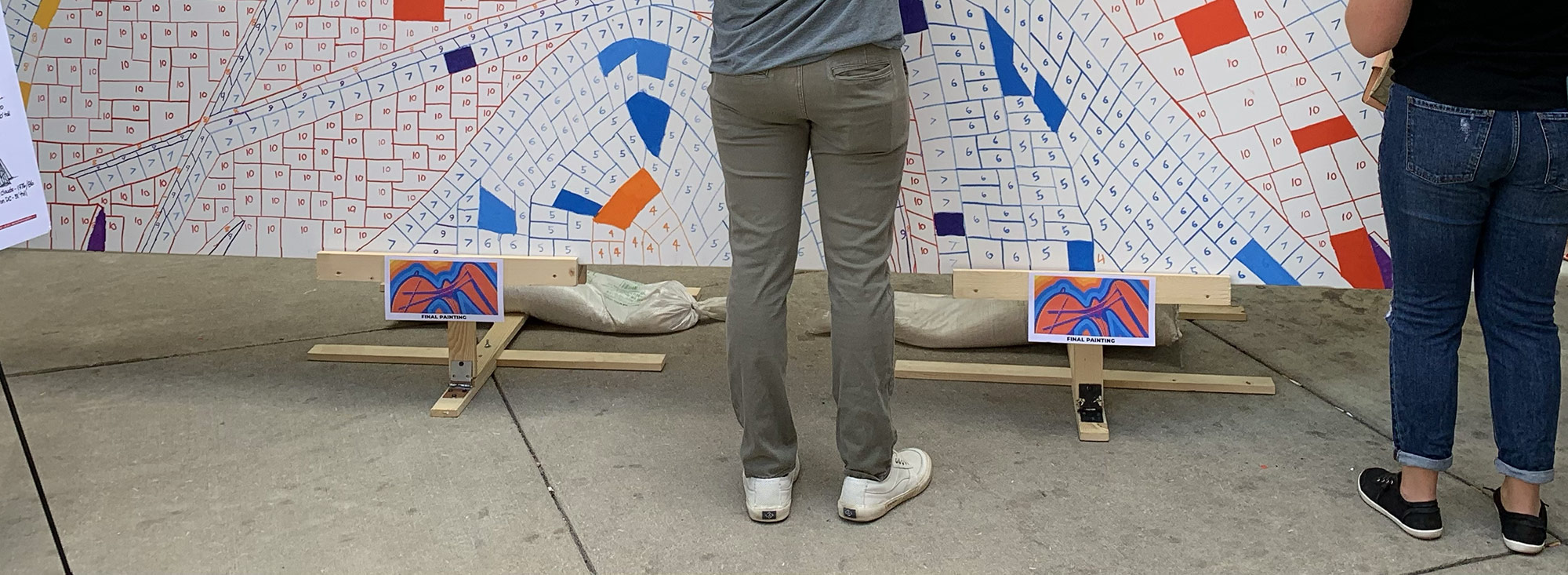
I’d long intended to have two 24″ x 36″ posters near the canvas that provided info about the paint times and about the sculptor Alexander Calder. I had designed these two posters on my computer (shown in their digital form below), but thought I’d challenge myself and execute them by hand on poster board. They ended up taking entirely too long to draw out and letter, but I used a digital projector to get the rough elements in the right place. I then used markers to add some color. The “descriptor” sign as I call it, intended to clearly state what the project was about, in the simplest of terms. “Paint The Calder – A 1,600 Person Paint-By-Number.” I added a couple of these 8.5″ x 11″ print-outs to the larger signs, so people could more quickly comprehend what we were doing. I also added the QR code signs so people didn’t have to search for where to vote.

This view shows the two side posters referring to Alexander Calder and the paint times. In the back, you can see the start of the Artist Mosaic poster, which was intended to show people what I was creating by taking their photos. I ended up adding to this poster a couple of times over the first two weeks before having the final version up during the last week.
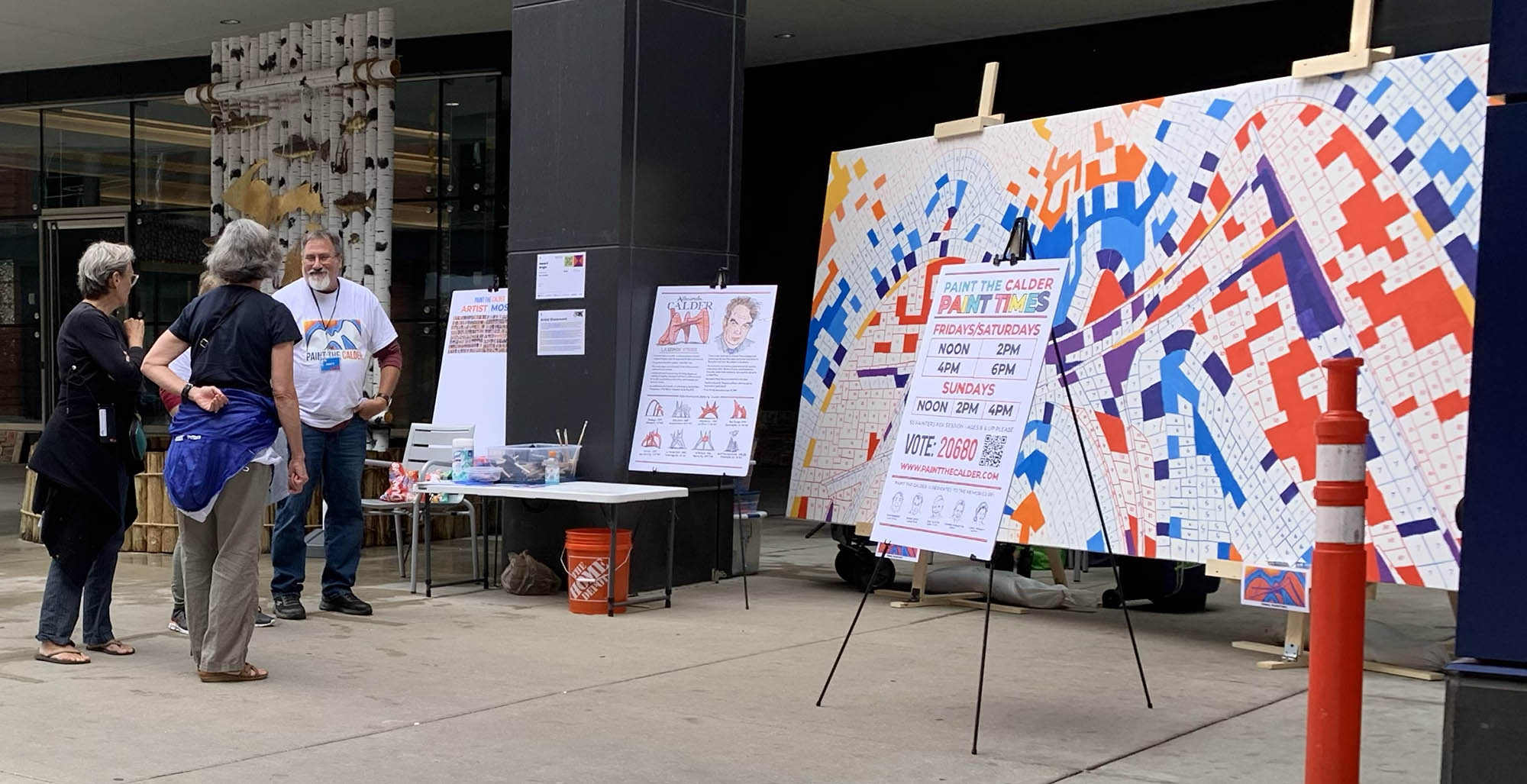
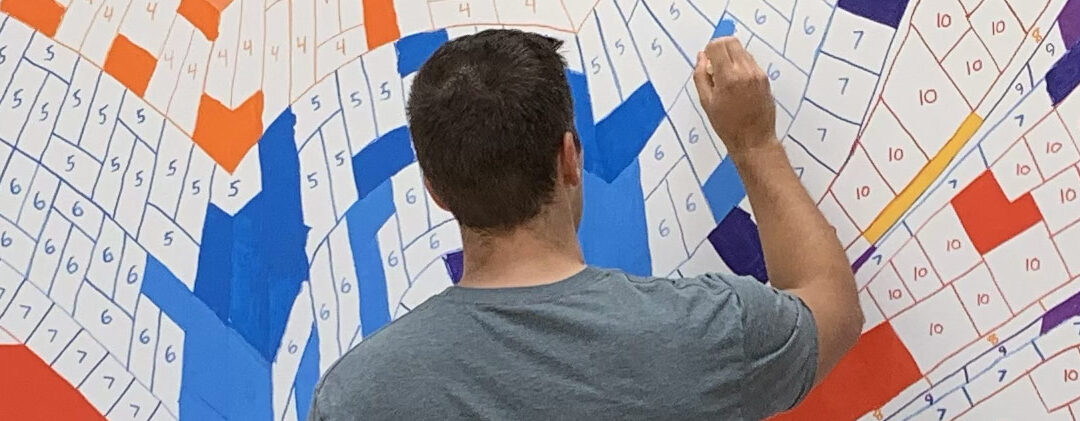
Day One – It Starts
Thursday evening (9/14): After we saw Dante paint his spot on the canvas, we saw a series of people walk by with varying looks on their faces. The area off the sidewalk that the canvas sat in was a bit hidden from south-bound foot traffic, so the canvas was a surprising site to many. The 6’ x 12’ size and mostly white appearance made it something people needed to study for a few moments before they had a reaction. There was no visible signage at that point to inform what the project was specifically about. Seeing the numbered spaces didn’t immediately resonate with people. One of us was usually quick to offer some encouragement in the form of “want to paint a square?” or more plainly “it’s a paint-by-number”. This was effective to connect the dots for most people. I would often describe the process for them too. “You pick a color and we give you a paint cup and brush”. This was usually enough to get a buy-in. They’d approach the table where my wife or a volunteer would welcome them with a card of swatches. Seeing the cups of paint on the table was often an effective reinforcement for what we were asking of them. Skeptical types would take a bit more time. Some would indicate a bit of resistance while often accepting the terms. Many would immediately express some sort of glee at the opportunity, or exclaim how wonderful the opportunity provided.
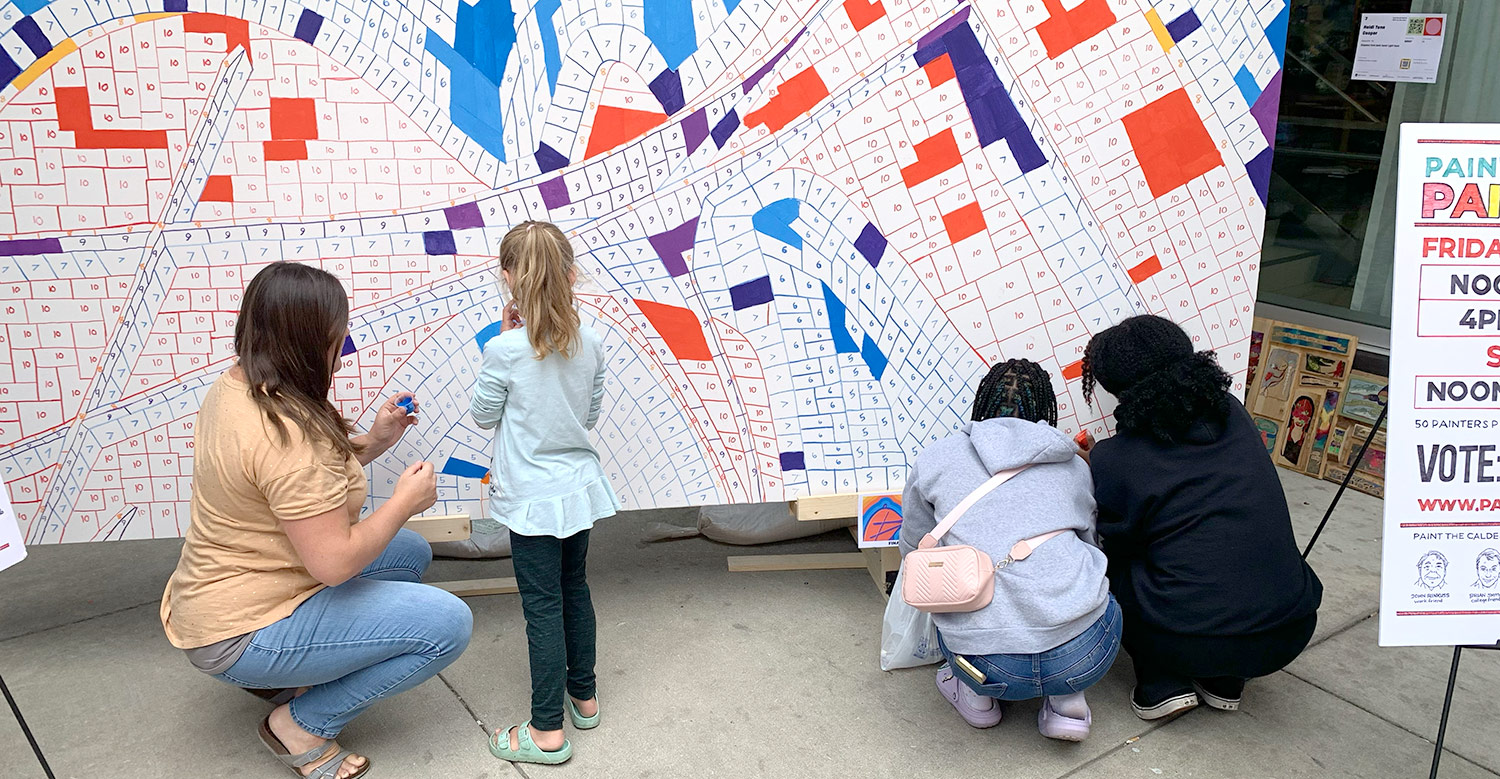
As each person approached the canvas, picked their spot and carefully filled the space (sometimes spaces) with paint, they frequently turned around with a big smile on their face. We would give them an I Painted the Calder sticker (which I joked was more popular than the painting). I would then try to be there to capture that smile for our Artist Mosaic. All of us working got a lift from the enthusiasm people showed. Comments such as “that was so fun” or “what an awesome idea” gave us the clue we were offering a unique experience. That first evening, we had a fairly steady stream of people but didn’t quite use all hundred cups of paint we’d packed. At the same time, we were pleased that those who painted had enjoyed themselves and that the weekend would be busier.

A Colorful Couple of Evenings
Working with the paint part of the project was certain to take some thought and effort. From selecting the color swatches, determining how much paint would be needed, to transferring the paint into hundreds of small cups, it would be the last major effort before the actual painting event would begin.
To determine how much paint would be needed, I painted a sample area on an old canvas that was roughly the same size as the areas on the real canvas. I determined that just about a teaspoon of paint would be enough. Of course, the paint could be applied heavier or thinner by the participant, but the teaspoon amount was a good place to start. From there, it was simply a matter of counting how many spaces there were of each color and doing a little math. After doing so, we ended up with a good idea of how much paint we needed.
Number of colored swatches per color:
– 1 Yellow: 6
– 2 Light Orange: 26
– 3 Orange: 56
– 4 Red Orange: 111
– 5 Blue: 191
– 6 Light Blue: 243
– 7 Dark Blue: 298
– 8 Orange: 110
– 9 Purple: 117
– 10 Red: 446 or 1 Gallon
The paint we purchased was available in three size: a sample jar, a quart and a gallon. One sample jar has 40 teaspoons of paint. One quart has 192 teaspoons of paint. One gallon has 768 teaspoons. From there, we were ready to purchase what we needed.
Somewhere I’d heard the idea of using syringes to transfer paint, so I purchased a 10-pack and started putting paint in the required number of cups for each color. After measuring how much a teaspoon of water filled the small cup, I was able to eyeball the amount as I began transferring the paint from the container to the cup. My wife Deb and I began the process on the Tuesday evening before ArtPrize began. We were able to get about three-quarters of the paint transferred before calling it a night and finishing up the following evening. Deb is my “logistics manager” so took command of how the paint cup organization proceeded.
After two evenings of transferring paint into roughly 800 cups, we were done (and tired of doing it!) but it felt good to be beyond that task. Depending on how the painting process went, we could reuse some of the cups for a second use, or perhaps purchase additional paint for the second weekend of painting if needed.
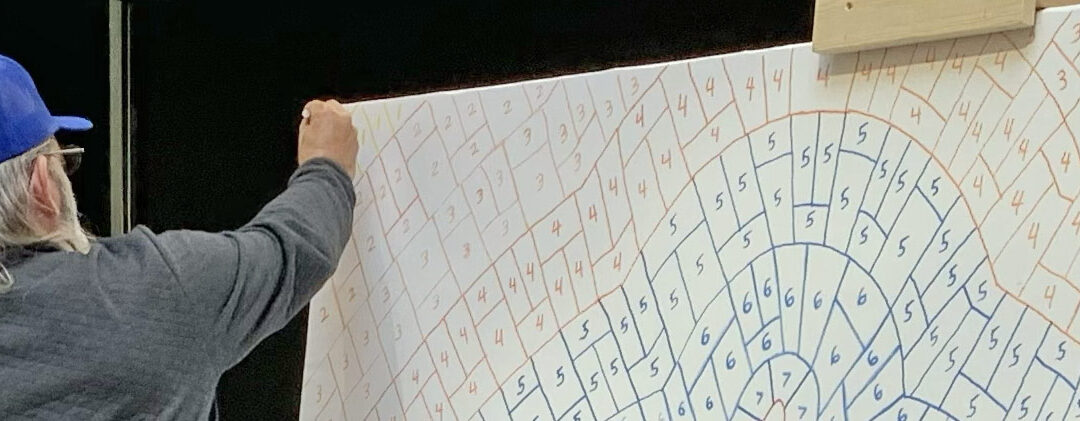
Thank You Dante
After Deb and I carted the canvas and easels to the Hyatt Place lobby, we sat it in a temporarily open space and were glad it was sitting safe and stable. I had an interview with a cameraman from Fox 17 the next day and met him on Wednesday the 13th of September to talk about the project. I asked if he wanted to capture me painting the first numbered rectangle and he thought that was a good idea. I painted the first orange spot on camera (and didn’t do a great job frankly).
When we pulled the canvas and easels outside the following afternoon to start public painting, a gentleman named Dante immediately expressed interest in being the first painter. It was nice to see someone ready to start the project with us. He wanted to paint the top corner yellow spot so that he’d be able to identify it in the future. I found a chair for him and he became public painter #1 and did an awesome job. Thanks Dante for starting the process!
Not everyone who passed by that afternoon immediately understood what we were doing. Due to the lack of painted spots, many people didn’t know what we were up to, or that they were invited to paint on the canvas themselves. I tried to remedy that a day or two later by posting a panel saying “A 1,600 Person Paint-by-Number”. This seemed to make things click for passerby’s and we were off to the races!
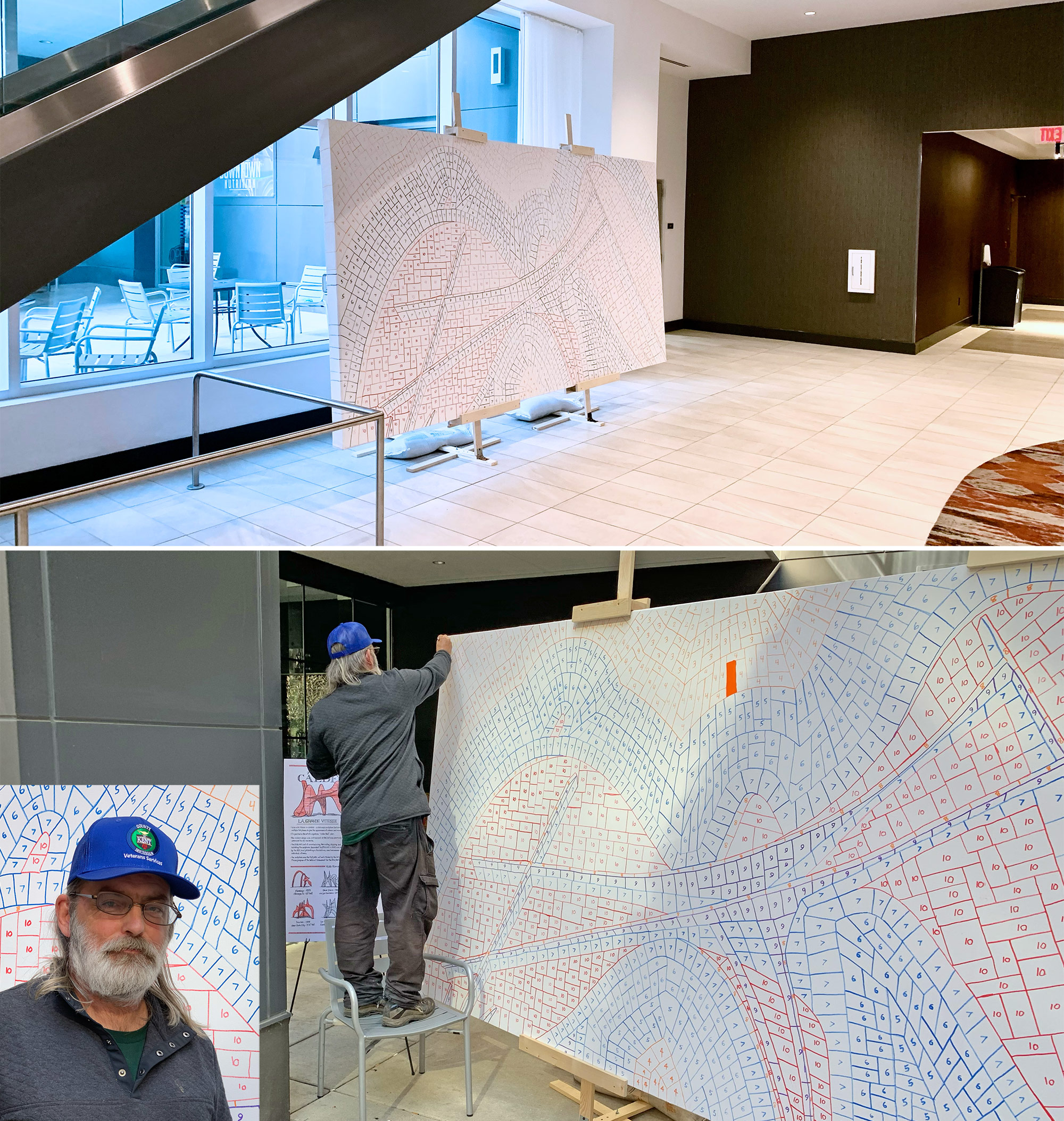

For more information, media contacts, or purchasing, email Howard Wright

